Report

Executive summary
This is the eleventh consecutive year that we have tracked the shopping behaviors of Chinese consumers. Our continuing research has given us a valuable long-term view across 106 fast-moving consumer goods (FMCG) categories purchased for home consumption in China. As in each of the past 10 years, we analyzed the key 26 categories1 that span the four largest consumer goods sectors: packaged food, beverages, personal care, and home care. We also looked at another 17 categories2 to form a more comprehensive view of the market. This report, which updates the findings from our China Shopper Report 2021, Vol. 2, A Sudden Slowdown in 2021’s FMCG Recovery … and the Mixed Fate of China’s Insurgent Brands, includes Kantar Worldpanel shopper behavior data for 2021 and the first four months of 2022.
In our report we will recap FMCG performance in 2021, during which many consumers exhibited distinct post-pandemic consumption behavior, and then report on the critical changes in that behavior during the first four months of 2022, with implications for consumer goods companies and retailers.
Written in collaboration with
Written in collaboration with

A look back at 2021
FMCG value made modest gains
The first quarter of 2021 delivered a welcome rebound after the devastating impact that Covid-19 had on FMCG performance in the same period of 2020. Then sales quickly slowed in the second and third quarters of 2021, only to speed up again in the fourth quarter. All told, FMCG value grew 3.1% in 2021 over 2020, maintaining a trend that started during the pandemic in which FMCG growth lags GDP growth.
That value growth and recovery was the result of a mini-boom in volume, which gained 4.1% in 2021 as consumers felt comfortable enough to make more frequent shopping trips and as they took advantage of volume promotions during the Double 11 and Double 12 shopping festivals. Yet the volume gains were tempered by a .9% drop in average selling prices, partly the result of those festival promotions.
Until the Covid-19 pandemic, FMCG companies enjoyed a steady five-year run of premiumization. Those companies are still increasing prices, but now consumers are adapting their behavior to compensate. They are becoming cautious again, but in different ways across different categories. More consumers wait to buy beverages and packaged food on promotions but opt to buy cheaper varieties of home and personal care products when they want them—or buy them in bulk.
Different paths for beverages and packaged foods
Among the four major sectors, beverage categories enjoyed the best performance in 2021, with 5.9% growth compared with a 4.1% loss in 2020. Carbonated soft drinks grew the most, gaining 16.7% in value. Genki Forest gave the market a big boost with its higher-priced, zero-calorie carbonated soft drinks, innovations that profited from the yearslong shift toward food and beverages that are perceived to be healthy. The same impetus helped the milk category grow value by 14.7%.
While beverages returned to healthy growth in 2021, packaged foods went in the other direction, losing 1.2% in value growth based on a 2% drop in volume and 0.8% increase in average selling price (ASP). The tentative end to Covid concerns in 2021 led consumers to curtail their practice of stocking up on instant noodles, for example, and that category saw volume drop by 9% in 2021.
Personal care and home care categories continued to grow in 2021 by 4% and 6%, respectively. Volume was up for both—personal care volume grew 3.6% and home care volume rose 7.5%. However, those gains were offset by ASP. Prices rose only .4% for personal care, and they dropped by 1.4% for home care categories. In makeup and personal wash, companies reacted to fierce competition by selling more on promotions, and local insurgents gained share with value products. There were some bright spots, though. For example, the personal care breakout category of 2021 was shampoo, which rose more than 10% in value.
The two-speed growth phenomenon we first identified in 2016 is still in evidence. Product categories that offer quality-of-life improvements such as cheese, mouthwash, fragrance, air freshener, and ready-to-drink coffee all grew by more than 20% in 2021. But another set of categories that had expanded during the 2020 lockdowns—such as disinfectant and hand wash—all lost 10% or more in 2021.
Average prices rise in China’s Tier 1 cities, decline elsewhere
Across the consumer landscape, it was China’s Tier 1 cities that exclusively contributed to higher prices—by 2.3%—and that was driven by offline consumption. But a 1.4% drop in volume in those large cities resulted in .8% value growth, below the pre-pandemic levels achieved in 2019. The lower the city tier, the bigger the price drops in online FMCG sales. This was due to shoppers shifting to such value-oriented platforms as Pinduoduo and Kuaishou, or to livestreaming and community group-buying platforms. Having established a solid base in lower-tier cities, PDD and Kuaishou have plans to penetrate Tier 1 and Tier 2 cities.
E-commerce was the only channel to maintain solid growth in 2021, although that growth slowed to 15% from the 30% range of previous years, and e-commerce platforms became increasingly fragmented, with more consumers shifting to options like Pinduoduo and interest-e-commerce platforms (Douyin and Kuaishou). The best companies are responding to these and other changes by reevaluating their e-commerce channel strategy across platforms, striving for portfolio differentiation and specialized operations capabilities to reach different consumer segments and satisfy different needs.
The Covid pandemic accelerated the rise of online-to-offline (O2O) commerce. O2O sales doubled in 2020 and grew 2.6-fold in 2021. As we explain in the full report, there are four models for O2O: offline retailers, vertical grocery, community-based buying platforms and horizontal marketplaces. Fully 83% of the FMCG sales generated in O2O represent a shift from offline sales, and among those sales, 17% is purely incremental business to the categories purchased. When O2O cannibalizes pure offline sales, it usually impacts the larger channels of hypermarkets and supermarkets. The biggest boost to O2O sales in 2021 came from community group-buying platforms and horizontal marketplaces.
Small brands and local brands winning
The long-tail brands (insurgents) continued to gain share from larger brands in most categories in 2021, with the biggest share gains by smaller brands in fabric softener, ready-to-drink tea, and carbonated soft drinks. However, those top brands started to regain lost share in a few categories, such as hair conditioner, packaged water, makeup, and infant formula.
Similar to previous years, local brands on aggregate gained share against foreign brands in these 26 categories in 2021. Interestingly, local brands focused on volume growth while foreign brands relied on premiumization to grow.
What’s ahead in 2022
Covid’s shadow on FMCG performance
China’s market for fast-moving consumer goods was dealt a blow when some of the country’s biggest cities started locking down in March and April. It was an unwelcome return to the anxious, troubling early days of the pandemic in 2020, and consumers’ worries were reflected in their purchasing behavior. Shoppers stocked up by purchasing food and home care products in larger pack sizes. With nowhere to go, they spent less on categories such as high-priced skin care and makeup.
Most FMCG companies are now struggling to deal with the effects of the lockdowns. Yet the forward-looking companies have acknowledged that their 2022 performance will be disappointing and volatile, and they are solidly focused on what lies ahead, using as a guide the trends that emerged in H2 2020 after the pandemic’s first major wave ended. In a way, they are looking back to help them plan their future.
Turbulence and uncertainty are likely to remain concerns for a large part of 2022, with consumers responding by becoming increasingly more price sensitive in many categories.
The FMCG dynamics of 2021 continued into early 2022 and then changed course in March and April, as Covid’s shadow reappeared in China. In the four weeks ending April 22, volume grew by 5.6% compared with the same period the year earlier, and ASP dropped by 5.7%, the biggest price decline in recent years, demonstrating enhanced consumers’ price sensitivity. As they did in 2020, shoppers will continue to stock up on food and home care products in larger pack sizes and spend less on higher-priced products, such as skin care and makeup, until the pandemic restrictions ease. In the meantime, though, lockdowns in major cities make it clear that at-home consumption will grow, as consumers’ homes, once again, serve as the center for work and entertaining.
But challenging times always create opportunities. The rise in at-home consumption will benefit many categories, especially in food and beverages and home care. Consumers’ growing concerns for health and hygiene will continue to spur growth in milk, personal wash, and other categories. The trend in which consumers shift their purchasing to midrange and mass segments will open potential for companies to sell products in these price tiers—something Chinese insurgents have done exceptionally well. Finally, emerging e-commerce options like livestreaming, PDD, and community group-buying platforms will grow their presence and influence, offering brands great access to lower-tier-city consumers—and, soon, consumers in Tier 1 and Tier 2 cities—in a more direct way.
Looking farther out into 2023, there is reason for optimism. The long-term fundamentals are in place for a return to healthy growth. Inflation remains relatively lower in China compared with Western markets, and the energy crisis is under control, with strong indications that the government is still striving to maintain GDP growth and is committed to balancing Covid clearance and economic development. A government stimulus package will also likely boost consumer spending power. Just as they have prepared for the challenging times, the best FMCG companies will prepare for a likely rebound.
Implications for brands and retailers
Implications for brands
Uncertainty introduced in 2020 by the outbreak of Covid was a dress rehearsal for volatility in the years to come. This year, amid another Covid outbreak in China against a backdrop of dynamic global geopolitics, we believe businesses may need to accept that volatility is the new normal. Companies should proactively practice scenario planning and be ready for various potential outcomes instead of counting on succeeding with a single plan. They should also build agile capabilities within their teams to react effectively. For consumer goods brands specifically, that means closely watching the following:
- Product/brand portfolio: Assess varying opportunities by price segment and city tier, customizing portfolio strategy to capture them with different product propositions, instead of focusing on only one segment.
- Supply chain optimization: Simultaneously manage the pressure on cost structure and the development of resilient supply chains to ensure business continuity under all scenarios. This will require companies to leverage a large supplier pool in different geographies (and in China in particular), and also to look for automation opportunities to reduce costs.
- Integrated online and offline route-to-market: Diversify into insurgent channels (such as PDD, livestreaming, and community group-buying platforms) in the short term and build direct-to-consumer capabilities to integrate online and offline channels in the long term.
Brands should also be optimistic about the future, and expect a much better 2023—similar to how 2021 compared with 2020. The fundamentals of the Chinese economy remain strong, with a growing middle class, continuous urbanization, and inflation under control. Brands should use the year 2022 to prepare for a strong rebound in 2023.
Implications for retailers
As we have seen again in Q2 2022, the retail landscape also will be profoundly impacted by Covid-19, and retailers need to:
- build resilient supply chains so that they can ensure business continuity even in the event of high disruptions
- redefine the retailing value proposition to shoppers in an increasingly digitalized and omnichannel environment
- focus on categories where there is a higher chance to win vs. online
- focus on fresh, high-quality food offerings and, more broadly, on categories with low online penetration
- price competitively to differentiate from online platforms
- double-down on O2O, prioritizing small to midsize stores and convenient locations
- provide consistent experience in offline stores, online self-owned app, community buying and other horizontal O2O platforms
- enhance the physical store experience, upgrading digital features to make stores more appealing to younger consumers
- reduce complexity in operations, look for alternative sourcing options and establish a new cost baseline in order to cope with the increasing input and energy costs.
The full report
A look back at 2021
In our report we will recap FMCG performance in 2021, during which many consumers exhibited distinct post-pandemic consumption behavior, and then report on the critical changes in that behavior during the first four months of 2022, with implications for consumer goods companies and retailers.
This is the eleventh consecutive year that we have tracked the shopping behaviors of Chinese consumers. Our continuing research has given us a valuable long-term view across 106 fast-moving consumer goods (FMCG) categories purchased for home consumption in China. As in each of the past 10 years, we analyzed the key 26 categories1 that span the four largest consumer goods sectors: packaged food, beverages, personal care, and home care. We also looked at another 17 categories2 to form a more comprehensive view of the market. This report, which updates the findings from our China Shopper Report 2021, Vol. 2, A Sudden Slowdown in 2021’s FMCG Recovery … and the Mixed Fate of China’s Insurgent Brands, includes Kantar Worldpanel shopper behavior data for 2021 and January through April of 2022.
FMCG performance rebounded strongly in the earliest months of 2021 compared with the devastating same period the year earlier. Personal and home care total spending made the biggest gains. Then, FMCG sales across most categories sharply retreated for the second and third quarters, only to rebound slightly in the fourth quarter (see Figure 1).
China’s overall FMCG market rebounded slightly in the fourth quarter of 2021, growing at 2.1% over the same quarter in 2020
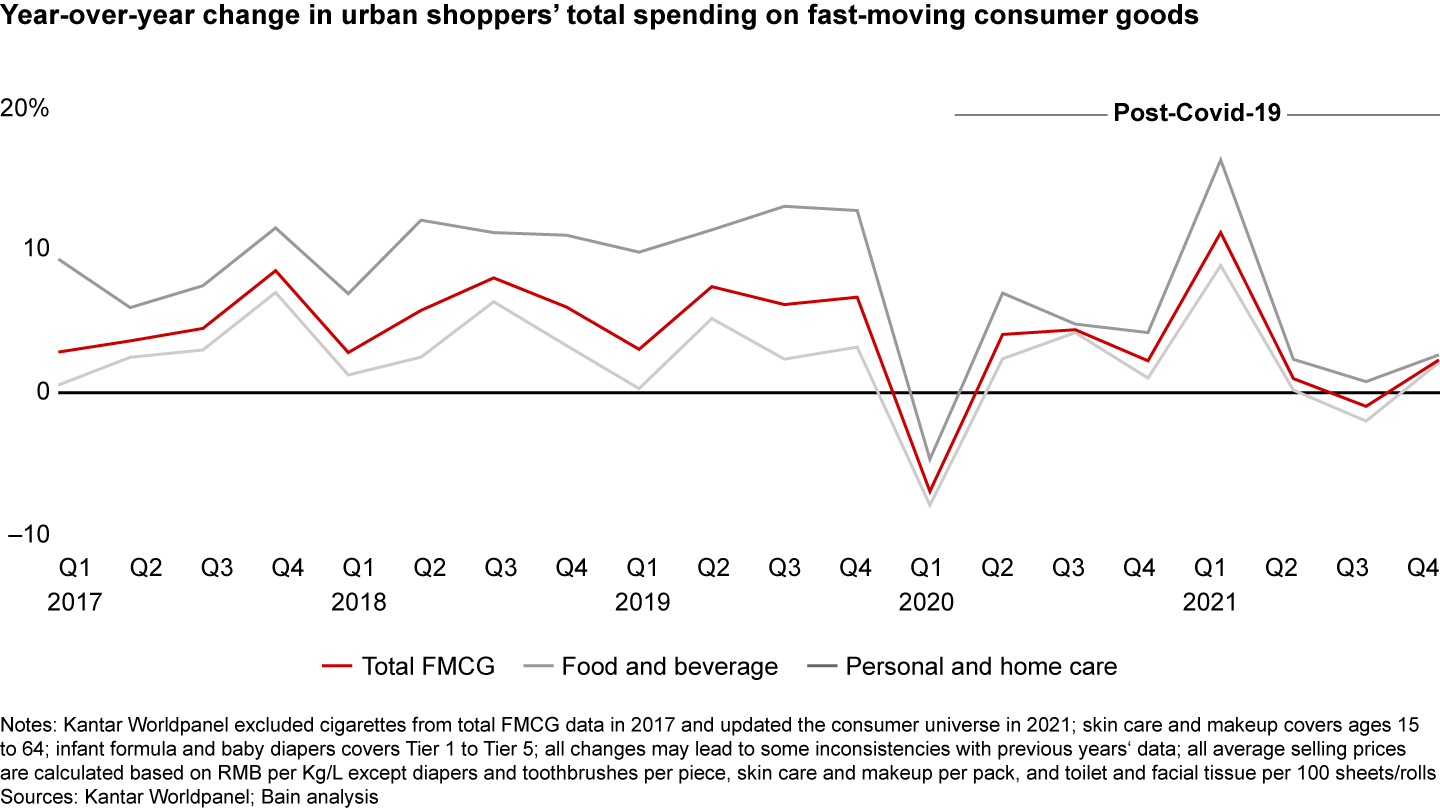
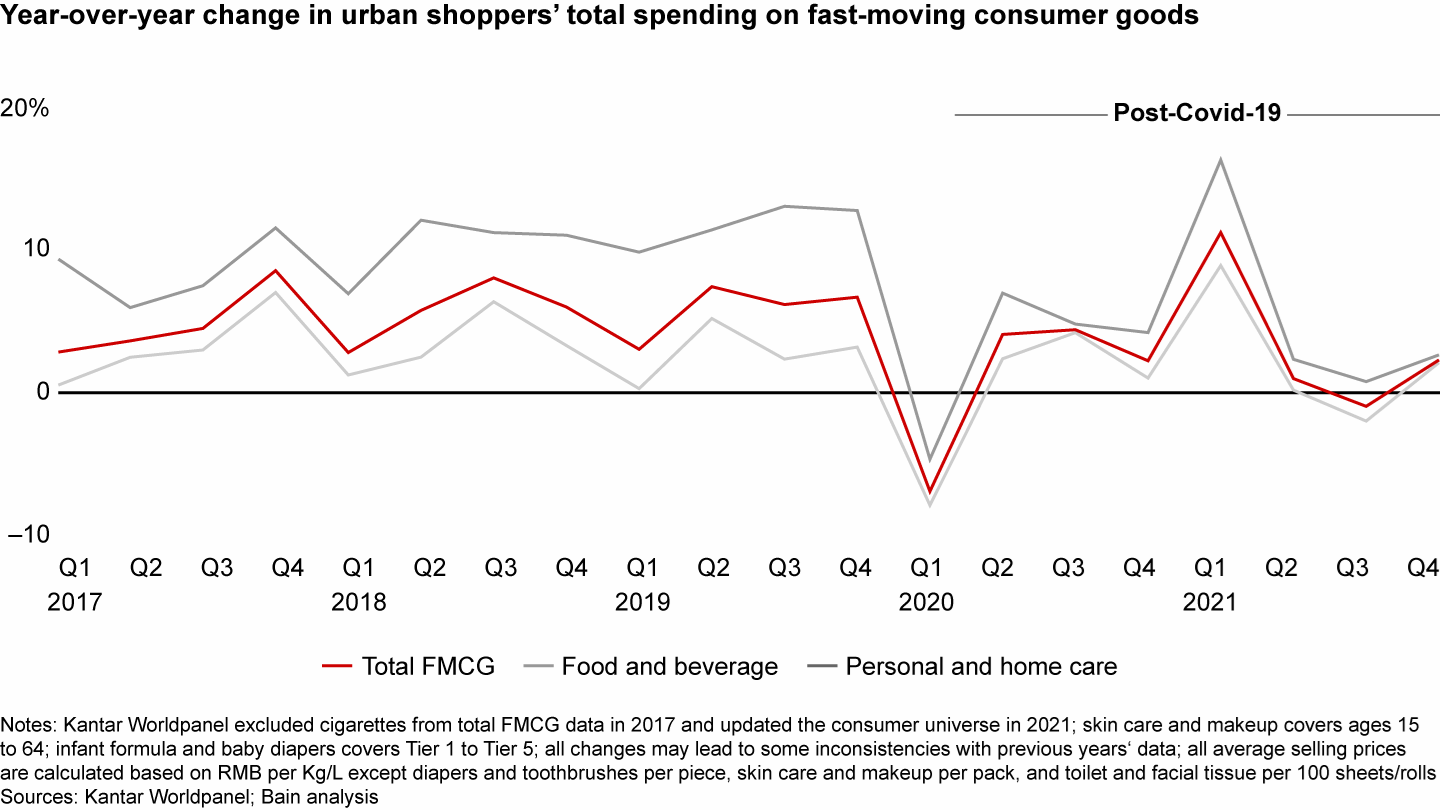
Overall FMCG value grew by 3.1% in 2021, maintaining a trend that started during the pandemic in which FMCG growth lags GDP growth. With Covid restrictions eased, consumers made more frequent trips to stores in 2021. That contributed to a 4.1% gain in volume growth for the year. However, consumers also took advantage of heavy promotions, such as those offered during Double 11 and Double 12 shopping festivals in the fourth quarter. That was a factor in the .9% drop in average selling prices (see Figure 2). The wide swing in performance throughout the year is best illustrated in the 10.6% value growth in the first quarter and –1% value growth in the third quarter (see Figure 3).
Overall FMCG value in 2021 grew by 3.1%, with the recovery driven mainly by volume growth as price deflation continued
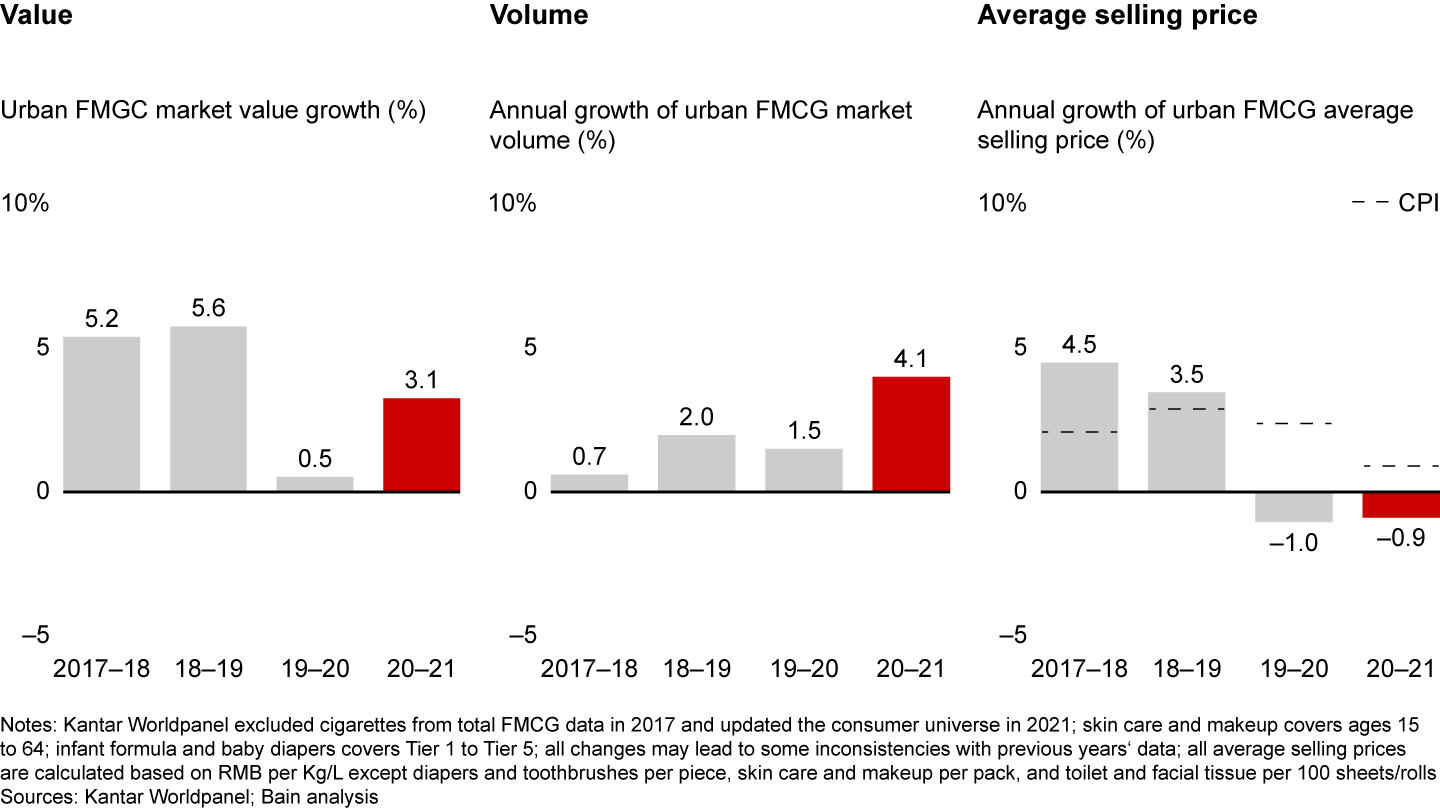
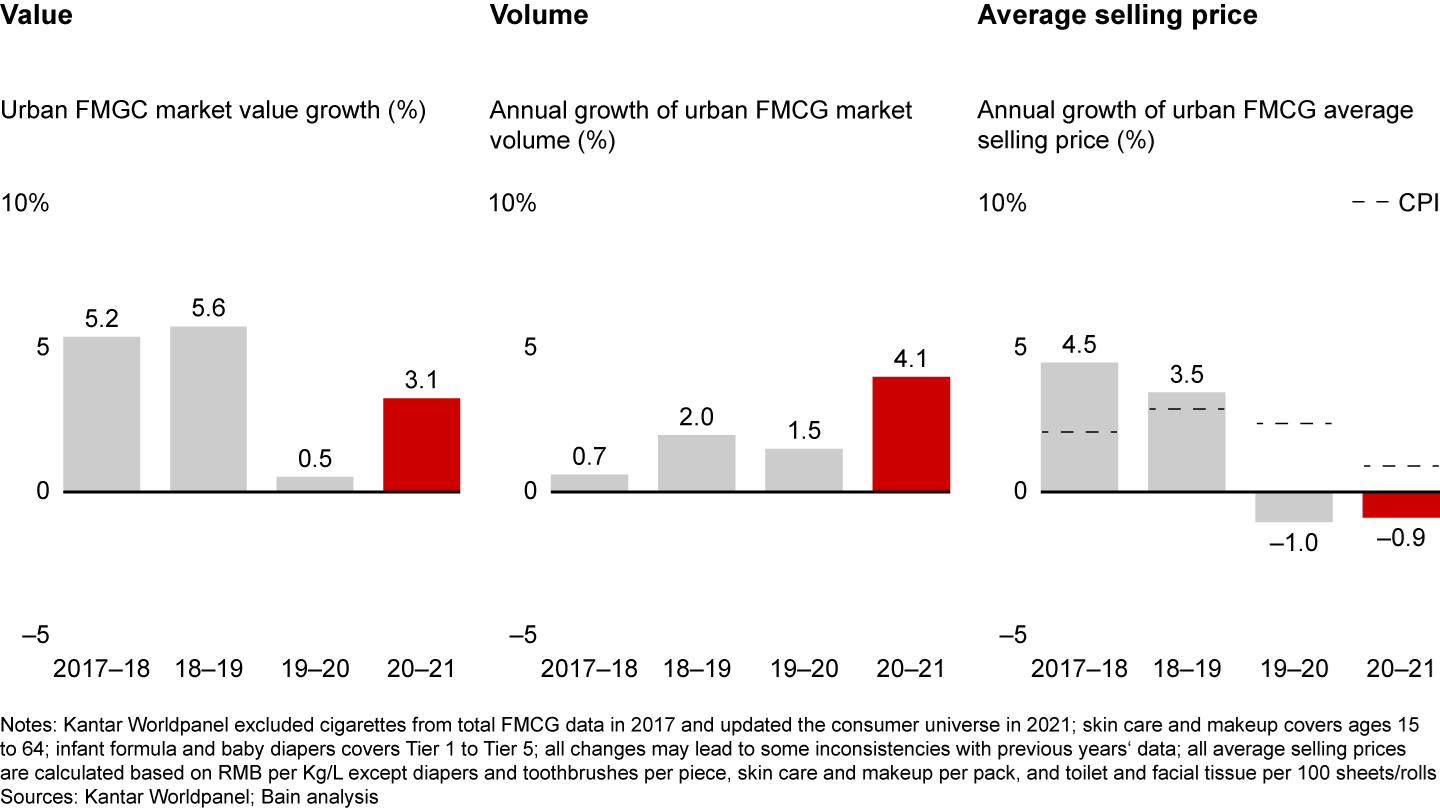
After the expected rebound in the first quarter of 2021, the FMCG market showed an increased price sensitivity
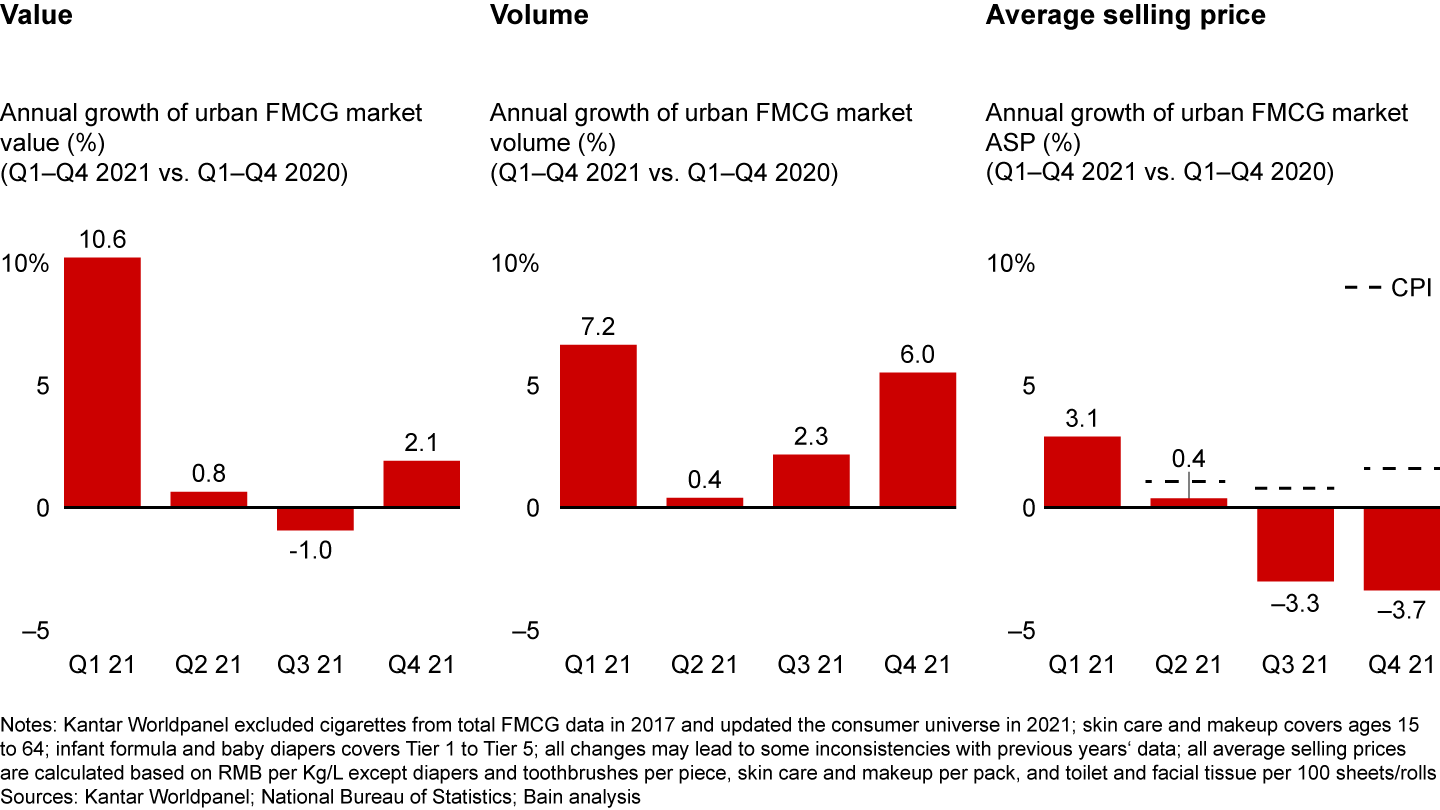
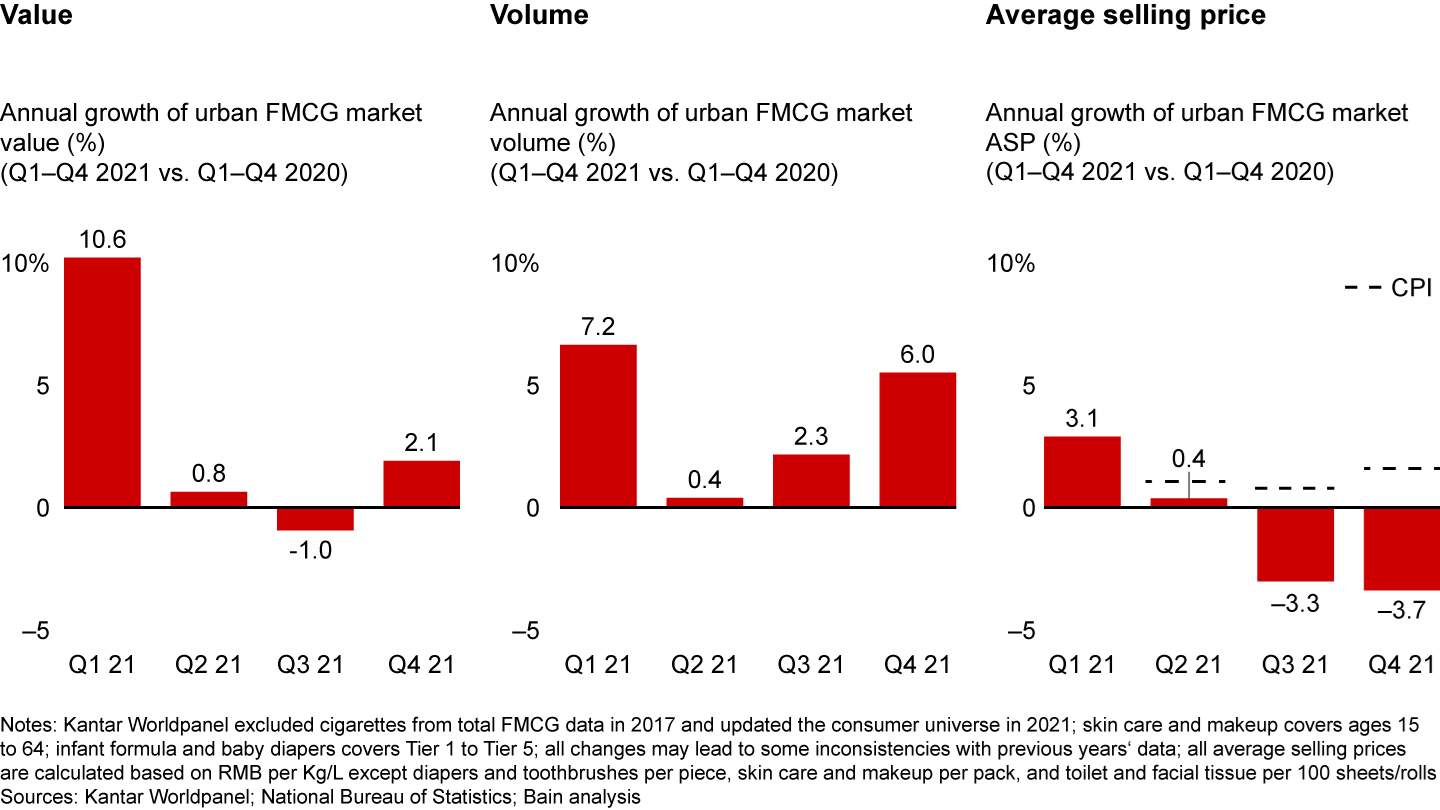
Until the Covid-19 pandemic, FMCG companies enjoyed a steady five-year run of premiumization. Those companies are still premiumizing through innovation, trade-up strategies, or price increases, but consumers are adapting their behavior to compensate—and in different ways across different categories. For example, when it came to buying packaged food and beverage products in 2021, more consumers were willing to wait to purchase on promotions (see Figure 4). Yet when consumers bought personal care and home care products, more opted for cheaper goods or bulk purchases that effectively lowered the per-unit cost.
In food and beverage, consumers waited for promotions; in personal care and home care, consumers opted for cheaper products or bought in bulk
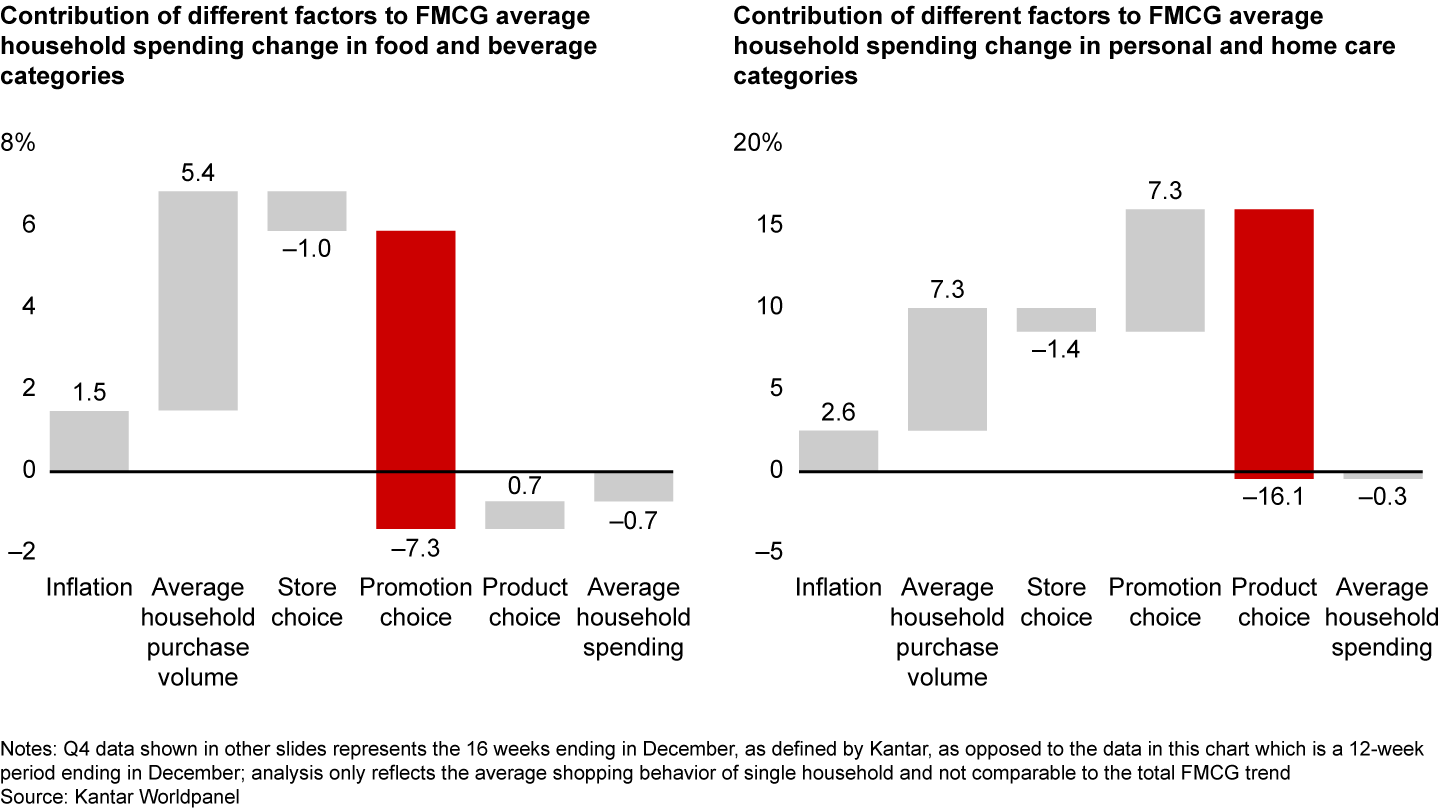
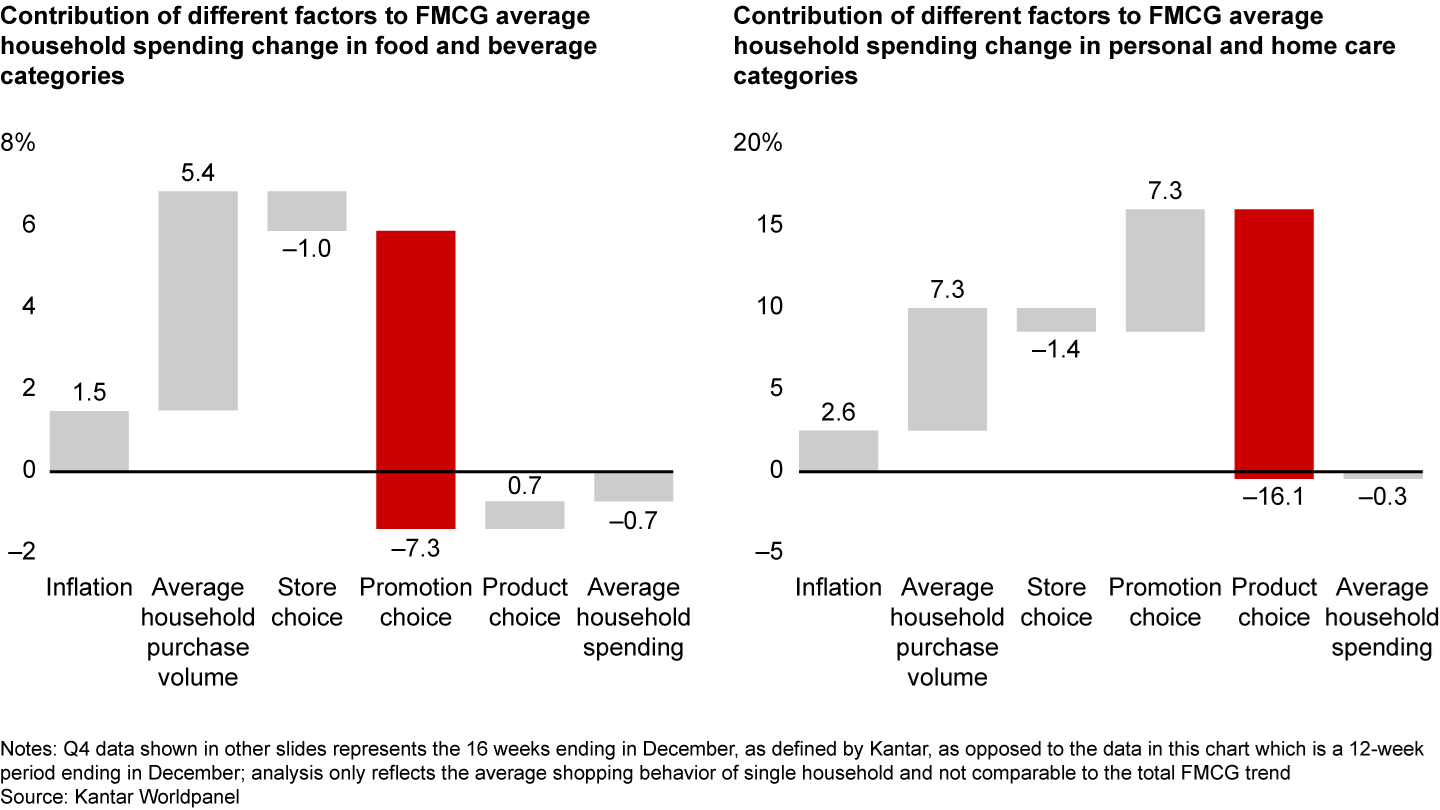
The fact that more categories experienced average price declines, or slight price increases below CPI, means that in 2021, most categories among our 26 categories had real price declines, continuing a deflationary trend already observed in 2020 (see China Shopper Report 2020, Vol. 2, After Five Years of Premiumization, Covid-19 Delivers Deflation in China FMCG). These deflationary trends are in sharp contrast with inflationary trends in input prices, putting pressure on companies’ margins, and raising the prospects of higher consumer inflation in the future.
How the categories fared
Among the four major sectors, beverage categories enjoyed the best performance in 2021, with 5.9% growth compared with a 4.1% loss in 2020 (see Figure 5). Carbonated soft drinks grew the most, gaining 16.7% in value. Genki Forest and other beverage players gave the market a big boost with their higher-priced, zero-calorie carbonated soft drinks, an innovation that profited from the yearslong shift toward food and beverages that are perceived to be healthy. The same impetus helped the milk category grow value by 14.7%. Milk is still enjoying a rise in popularity from a statement made in April 2020 by Zhang Wenhong (张文宏), a prominent infectious disease expert, who recommended milk for its immunity-boosting qualities. KOL opinions led to a steady rise in demand for milk, to some degree at the expense of yogurt, which declined by 7.8% in value. Dairies took advantage of this trend by pushing the premium varieties in their milk portfolio. Packaged water continued a growth trend born in the pandemic, when consumers stocked up on water and maintained the habit of buying in bulk after restrictions eased in 2021. Another winner in beverages: Beer gained 6.7% in value as companies pushed premium and imported varieties.
The volume in packaged food and beverages moved in opposite directions from 2020’s performance
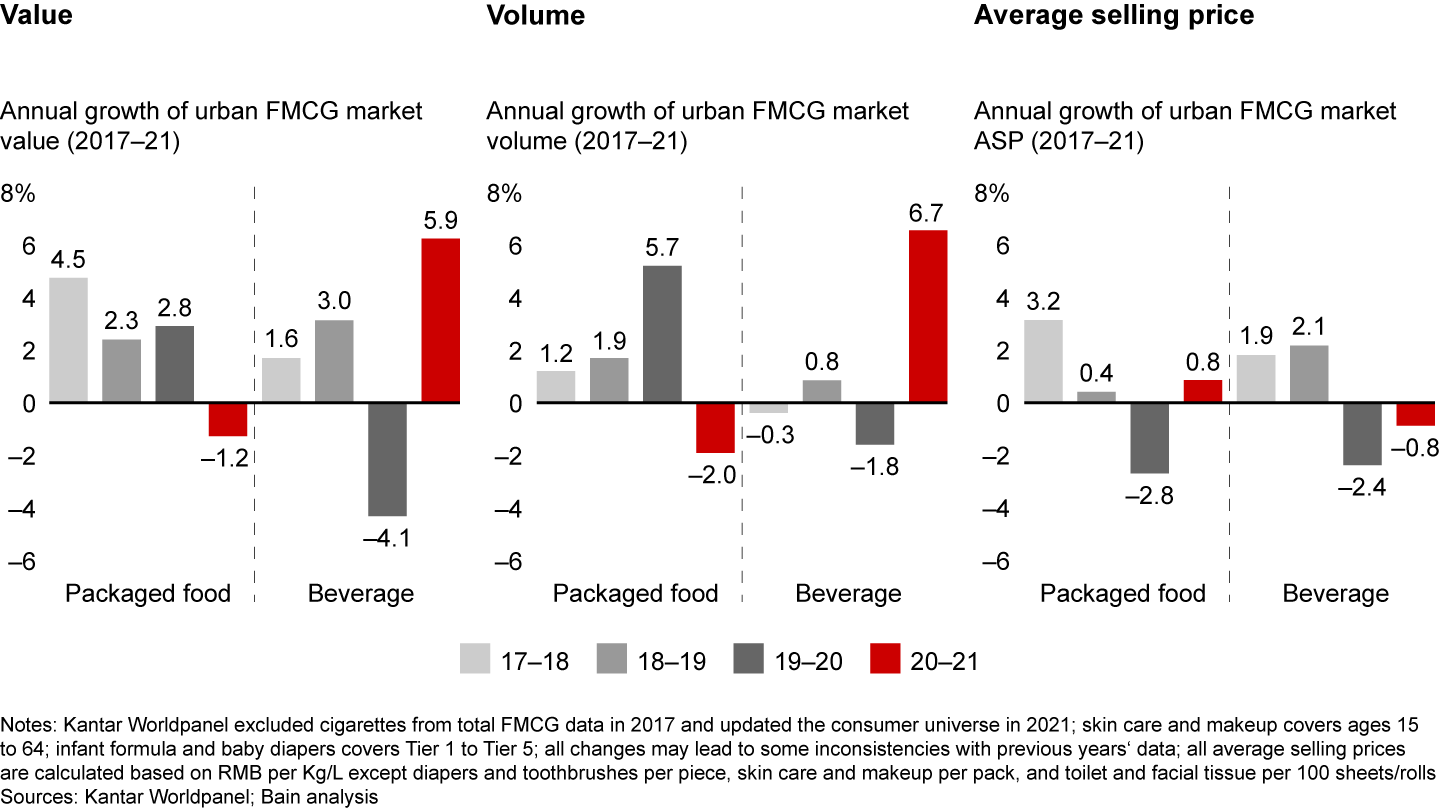
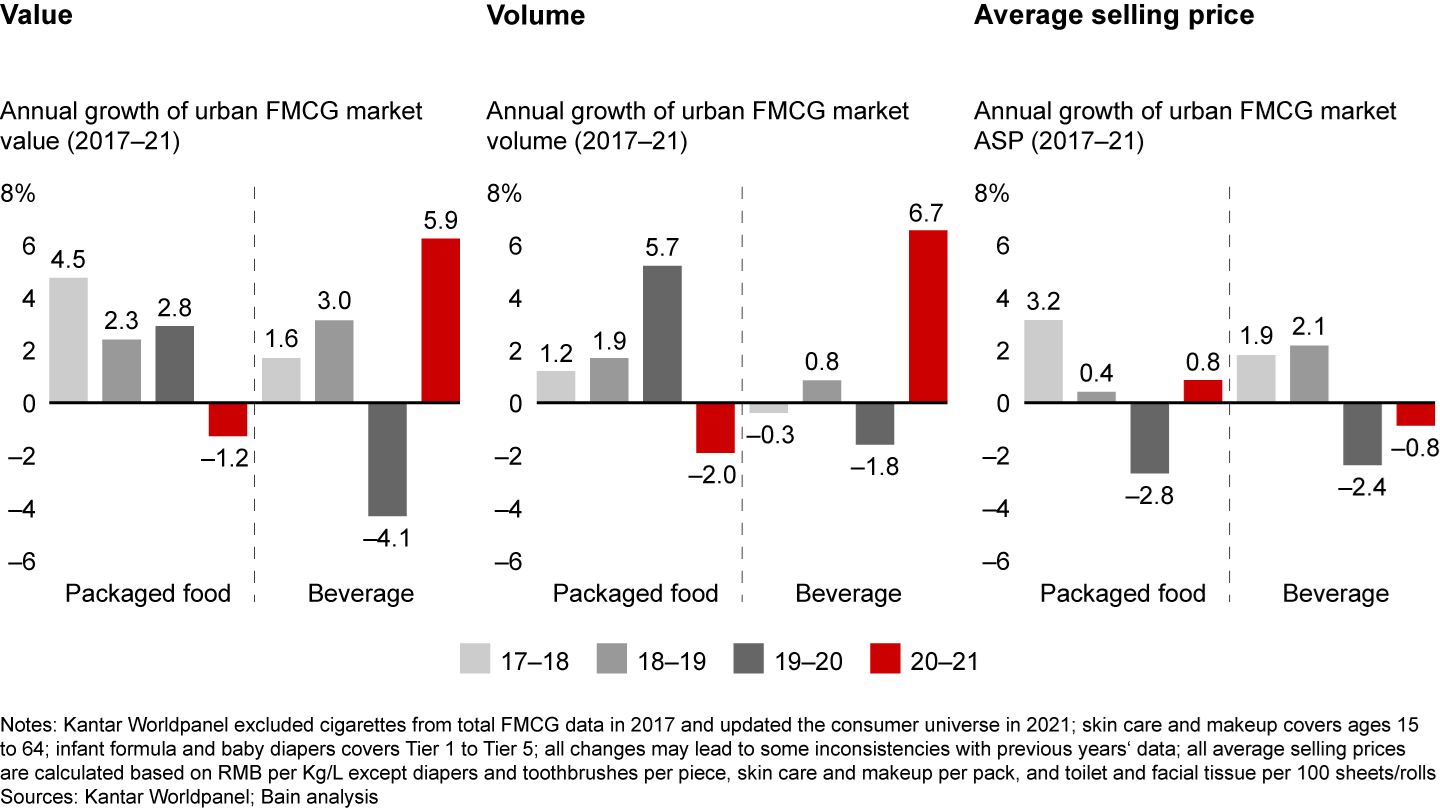
While beverages staged a comeback in 2021, packaged foods retreated, losing 1.2% in value growth based on a 2% drop in volume and .8% decline in ASP. Sellers of infant formula were able to raise prices, but the declining birth rate hurt volume. To find new sources of growth, some companies introduced milk powder for young children. Meanwhile, the tentative end to Covid concerns in 2021 led consumers to curtail their practice of stocking up on instant noodles; the category saw volume drop by 9% in 2021. Biscuits lost even more volume—11%—as more consumers shifted to premium brands like Oreo but bought less of them.
Personal care and home care categories continued to grow in 2021 by 4% and 6%, respectively (see Figure 6). Volume was up for both—personal care volume grew 3.6% and home care volume rose 7.5%. However, those gains were offset by ASP. Prices rose only .4% for personal care and they dropped by 1.4% for home care categories. At issue: Some makeup and personal wash companies reacted to fierce competition by selling more on promotions, and local insurgents gained share with value products. Though prices are down in home care, there are signs that the market for these goods is becoming more sophisticated, with advances in categories like kitchen cleaner, which grew 5.7% in value.
Personal care and home care continued to grow in 2021, both driven by volume, while the price of home care dropped
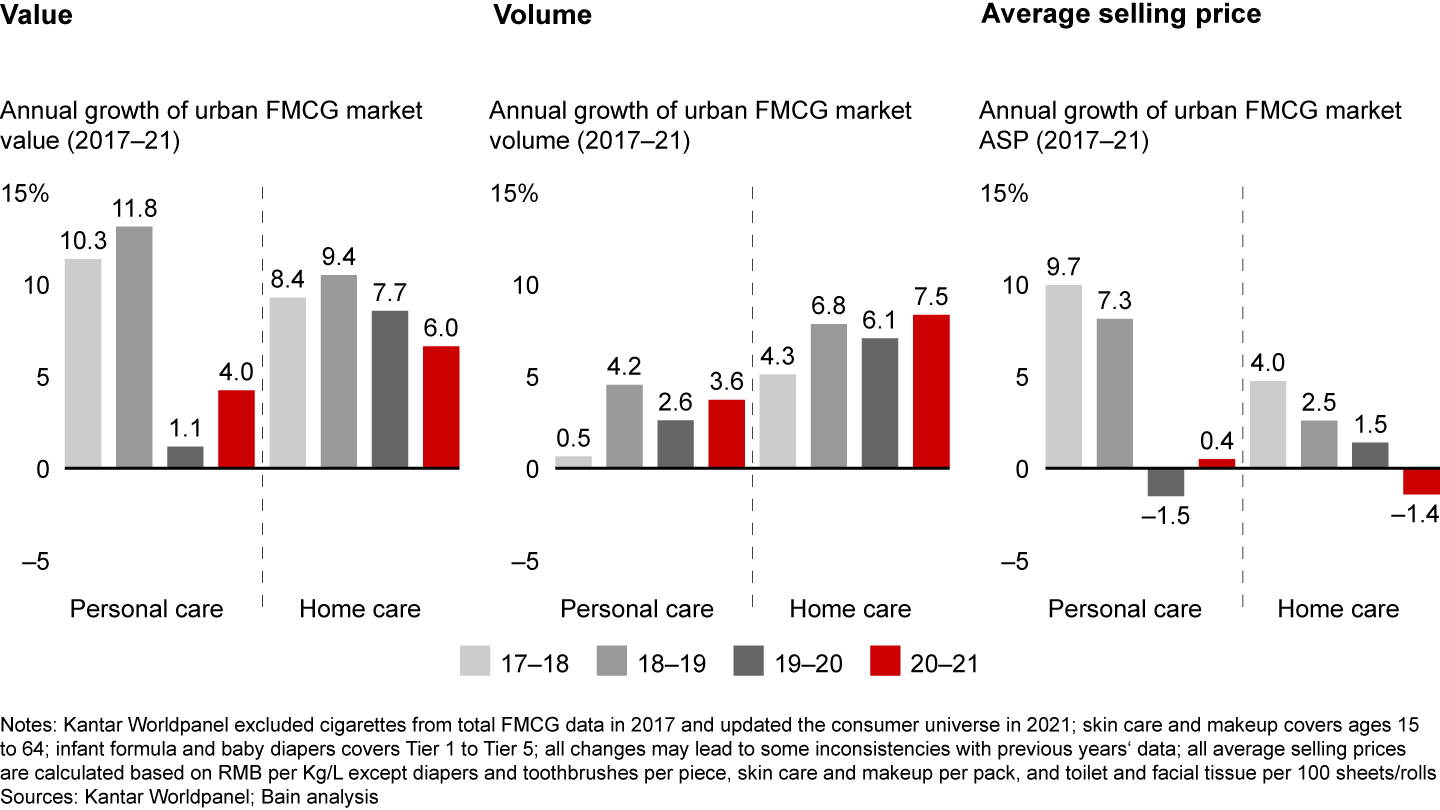
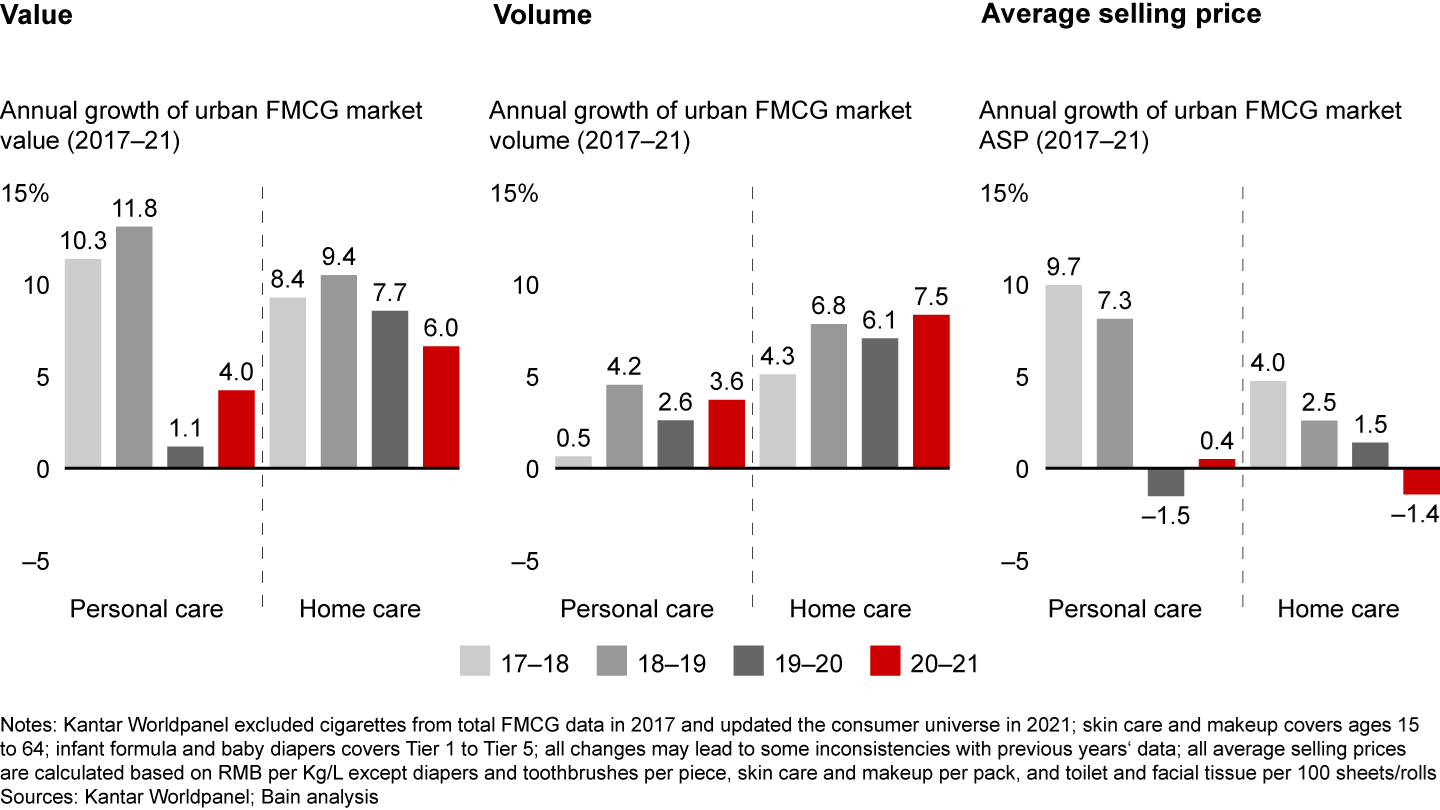
In personal care, the breakout category of 2021 was shampoo, which gained more than 10% in value since 2020. But compare the performance of shampoo with that of makeup, which grew by 5.5%. Both achieved roughly similar volume growth (9.2% for shampoo and 9.4% for makeup). However, while shampoo prices rose by 1%, makeup saw prices drop by 3.6%, in large part due to heavy promotions. Nearly 30% of all makeup in China was sold on promotion in 2021.
The two-speed growth phenomenon we first identified in 2016 is still in evidence. Product categories that offer quality-of-life improvements, such as cheese, mouthwash, fragrance, air freshener, and ready-to-drink coffee, all grew by at least 23% in 2021 (see Figure 7). Among the factors behind the record-setting popularity of cheese: insurgent Milkground’s highly successful invention of the cheese snack category. Originally launched for kids, the dairy later expanded the category for adults. But while those categories grew at a fast speed, another set of categories seriously lagged behind. Many categories that had expanded during the 2020 lockdowns because of home cooking and intense home cleaning—butter, tomato ketchup, instant noodles, disinfectant, and hand wash, for example—all lost 10% or more in 2021.
Two-speed growth continued in 2021, with categories offering quality-of-life improvements growing fast while home consumption categories declined
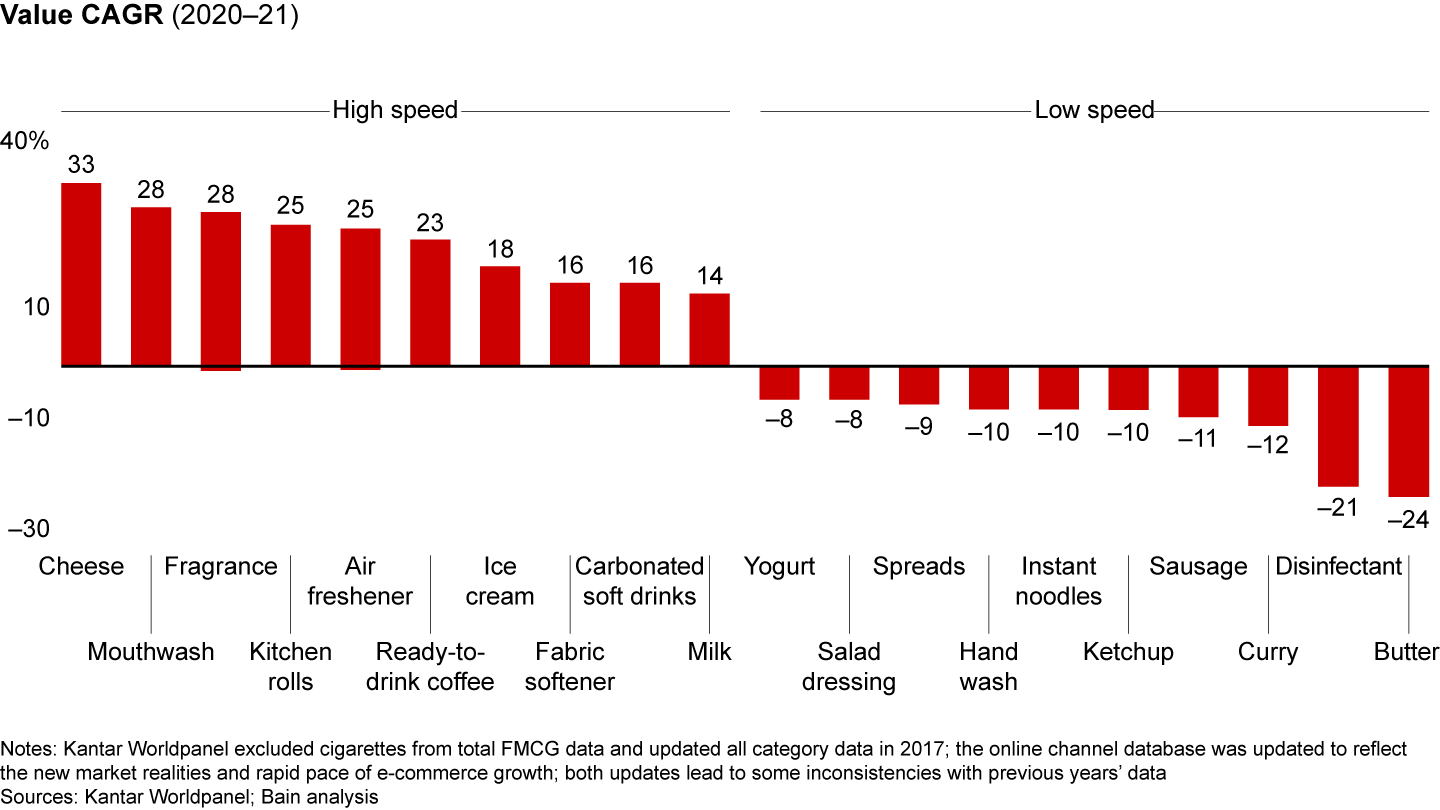
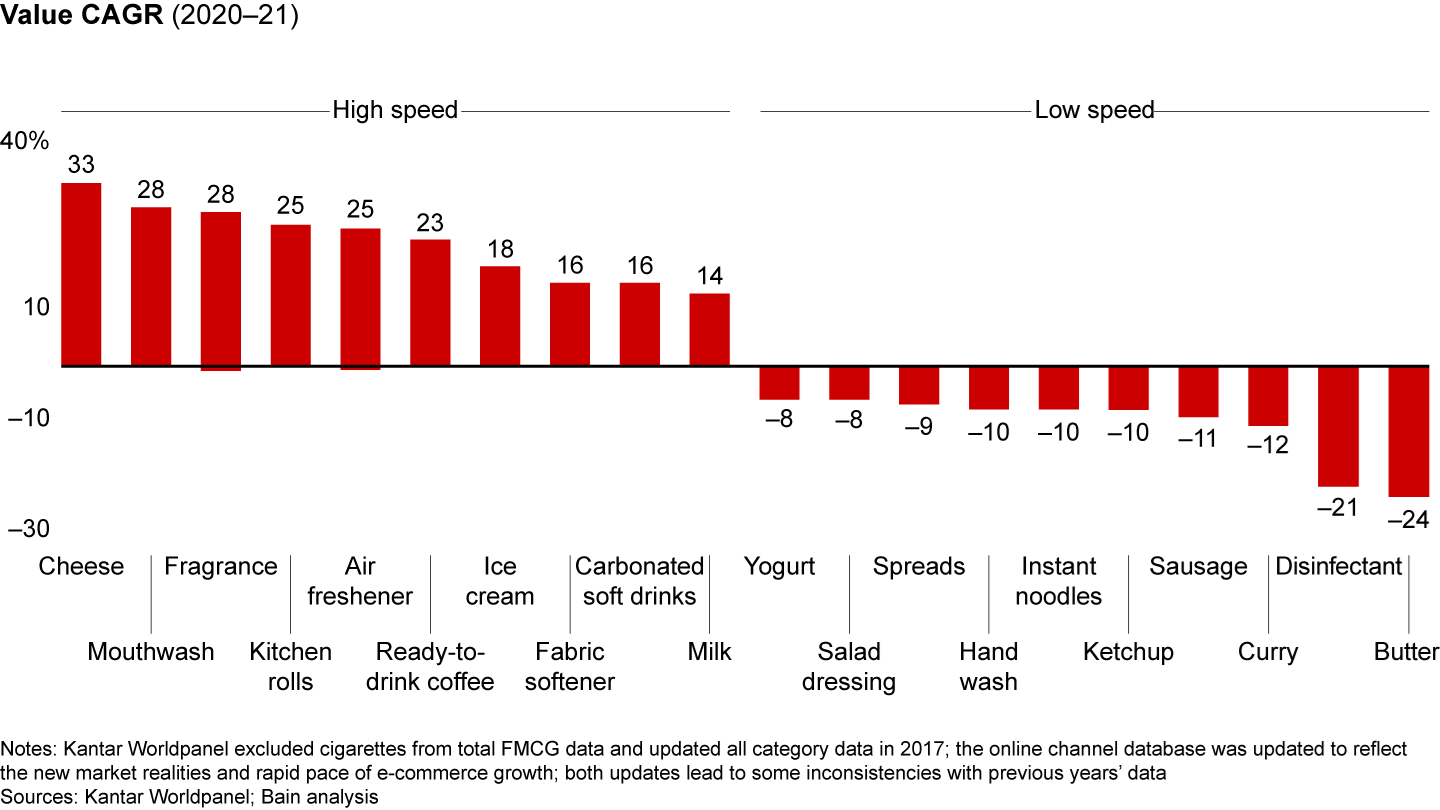
Where’s the premiumization?
China’s Tier 2 and Tier 3 cities together account for almost 60% of China’s total FMCG market, and they showed the strongest growth in 2021—3.7% and 4.1%, respectively (see Figure 8). But while those cities recovered relatively quickly from the impact of Covid in 2021 and are responsible for significant volume growth, they didn’t help to elevate pricing. It was China’s Tier 1 cities that exclusively contributed to higher prices—and that was driven by offline consumption. Those large cities actually saw volume drop by 1.4% but achieved a 2.3% rise in ASP. Still, Tier 1 cities’ value gain of .8% fails to bring it back to the prepandemic levels achieved in 2019.
Premiumization continued in Tier 1 cities while lower-tier cities saw volume gains and lower prices
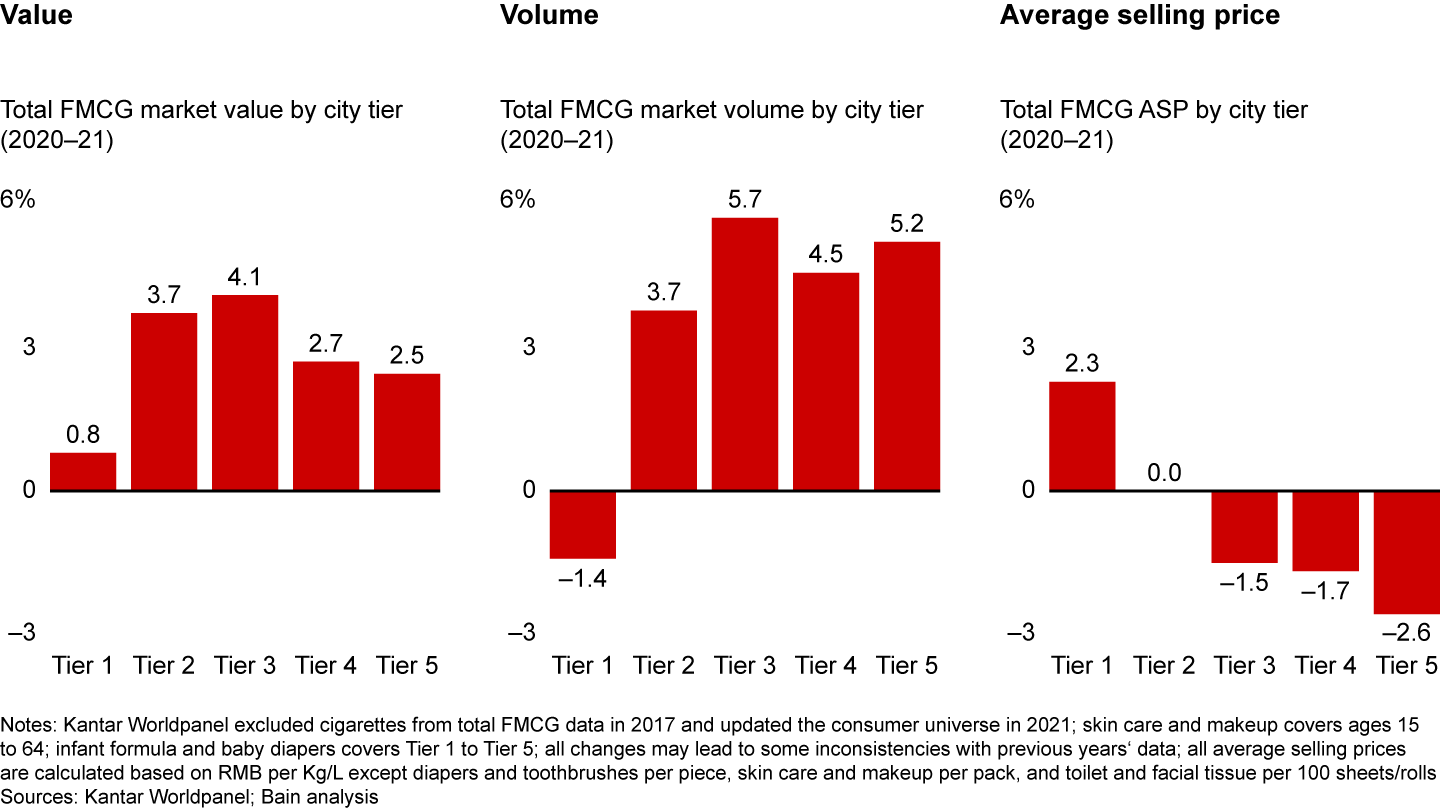
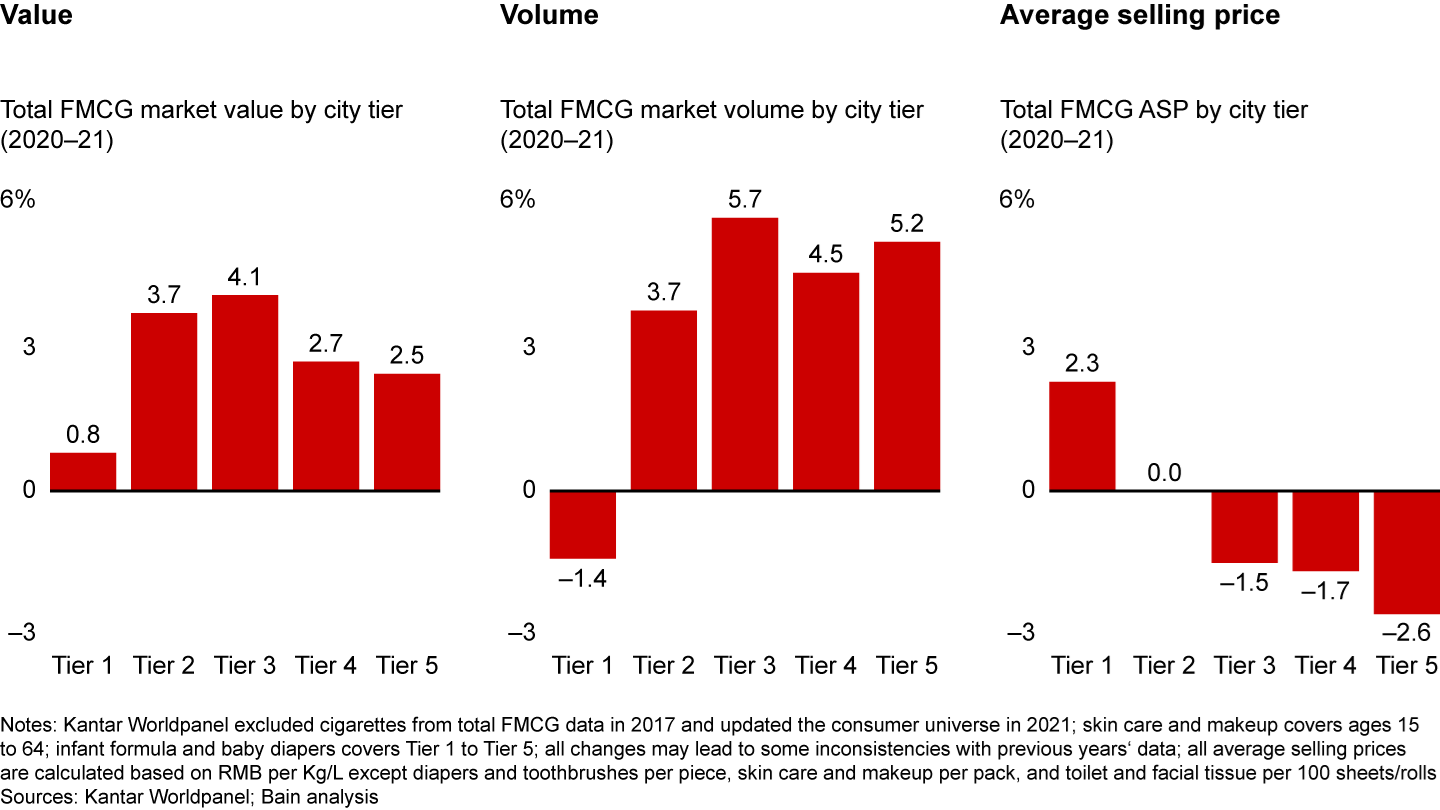
Our research determined a distinct trend: The lower the city tier, the bigger the price drops in online FMCG sales. This was due to shoppers shifting not only from offline to online but also from Taobao or JD.com to such value-oriented platforms as PDD and Kuaishou, or to livestreaming and community group-buying platforms. Having established a solid base in lower-tier cities, PDD and Kuaishou now have plans to penetrate Tier 1 and Tier 2 cities.
Slowing growth for e-commerce and online penetration
The Covid pandemic accelerated those channel trends already in place, such as the shift from offline to online sales and the rise of online-to-offline (O2O) commerce. It was no surprise that e-commerce was the only channel to maintain solid growth in 2021, although that growth slowed down to 15% from the 30% range of previous years (see Figure 9). Grocery stores' value share declined by 12% and hypermarkets by 4%, while convenience stores remained flat.
E-commerce remains the only retail channel gaining share, albeit with slower growth than in previous years
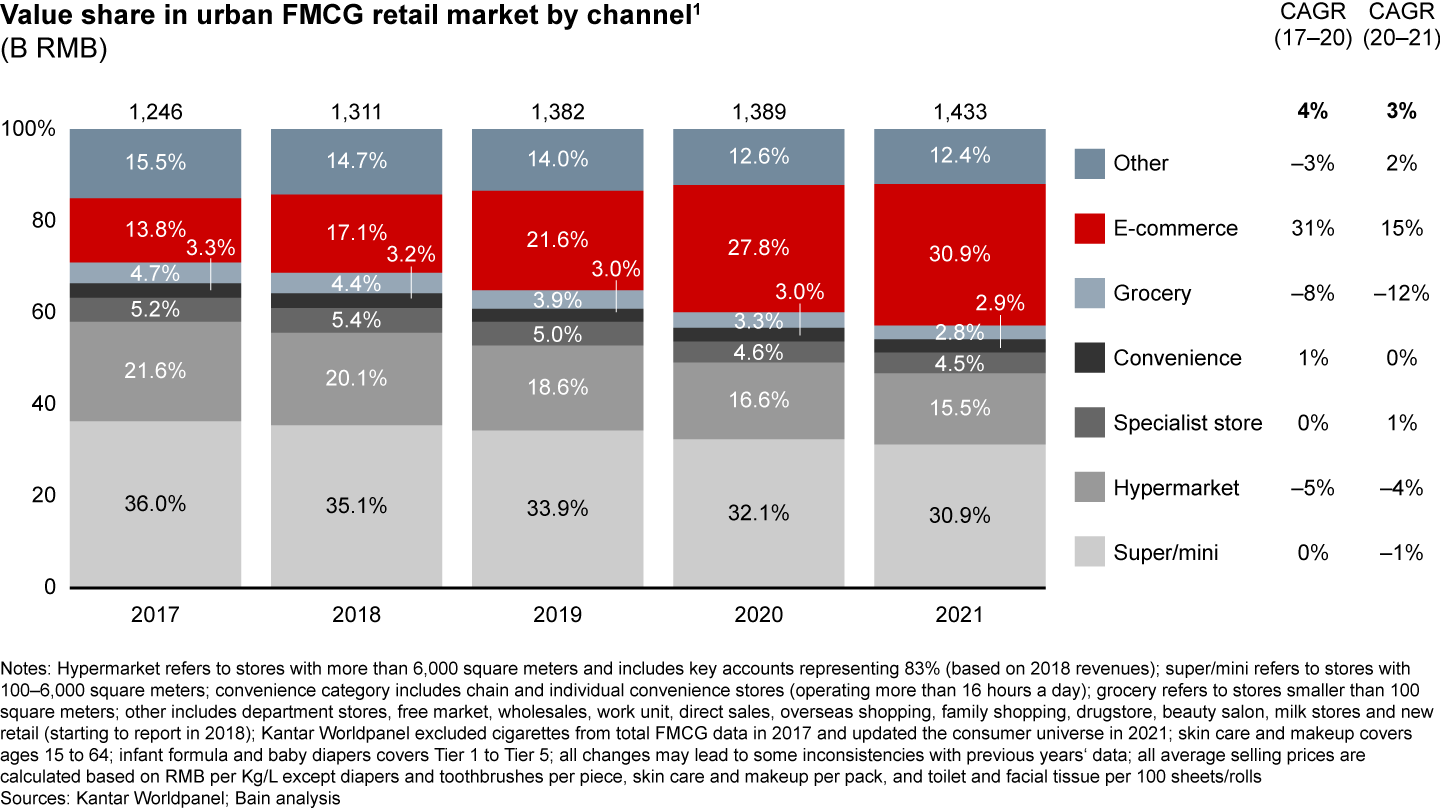
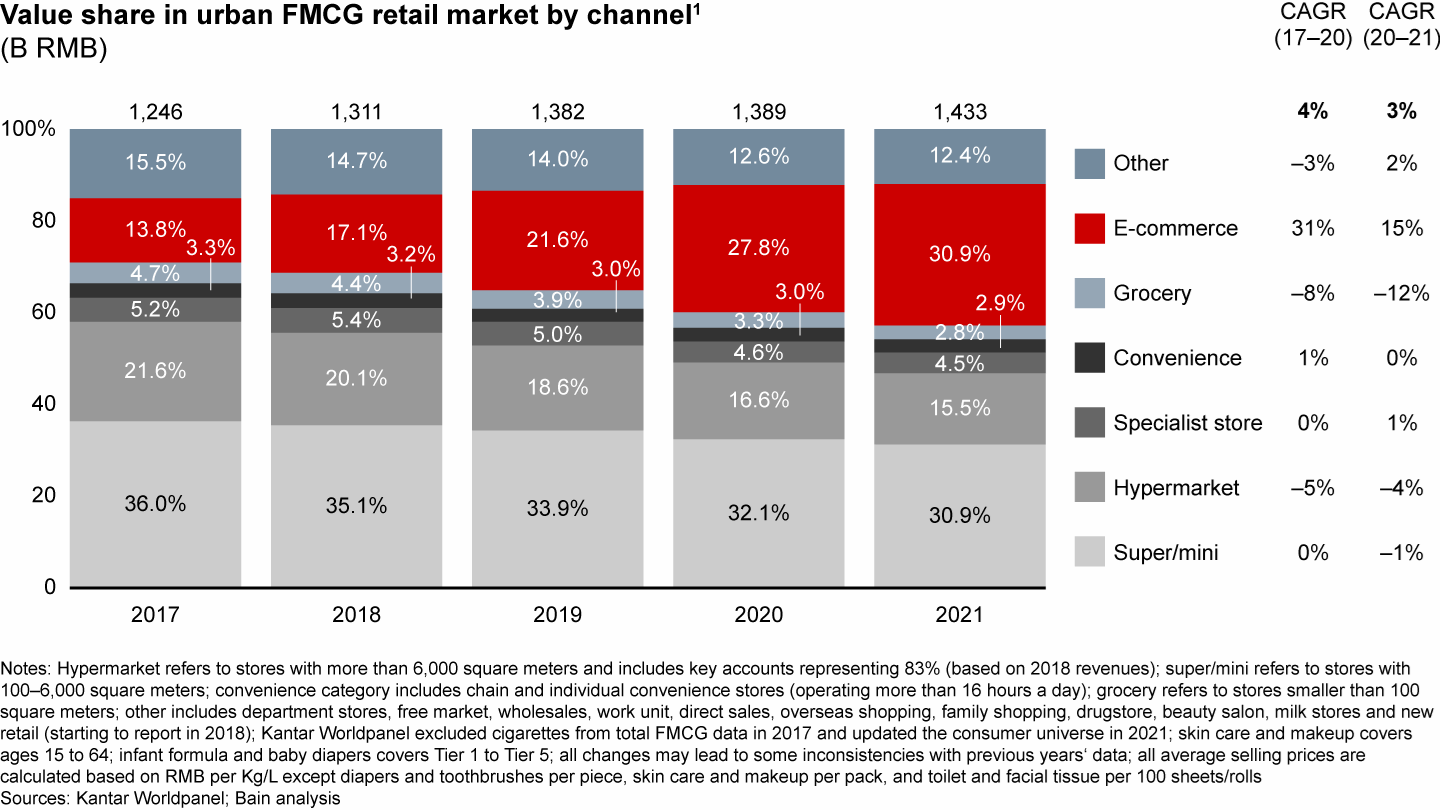
Online penetration continued to grow for all categories, but the growth rate slowed down, with most food and beverage categories lagging home care and personal care (see Figure 10). In previous years we saw two clusters of categories that had medium online penetration, but which gained penetration at more than 10% a year. That trend seems to have ended, indicating that each category might have its own online penetration limit.
Online penetration growth momentum slowed, with most food and beverage categories lagging home care and personal care
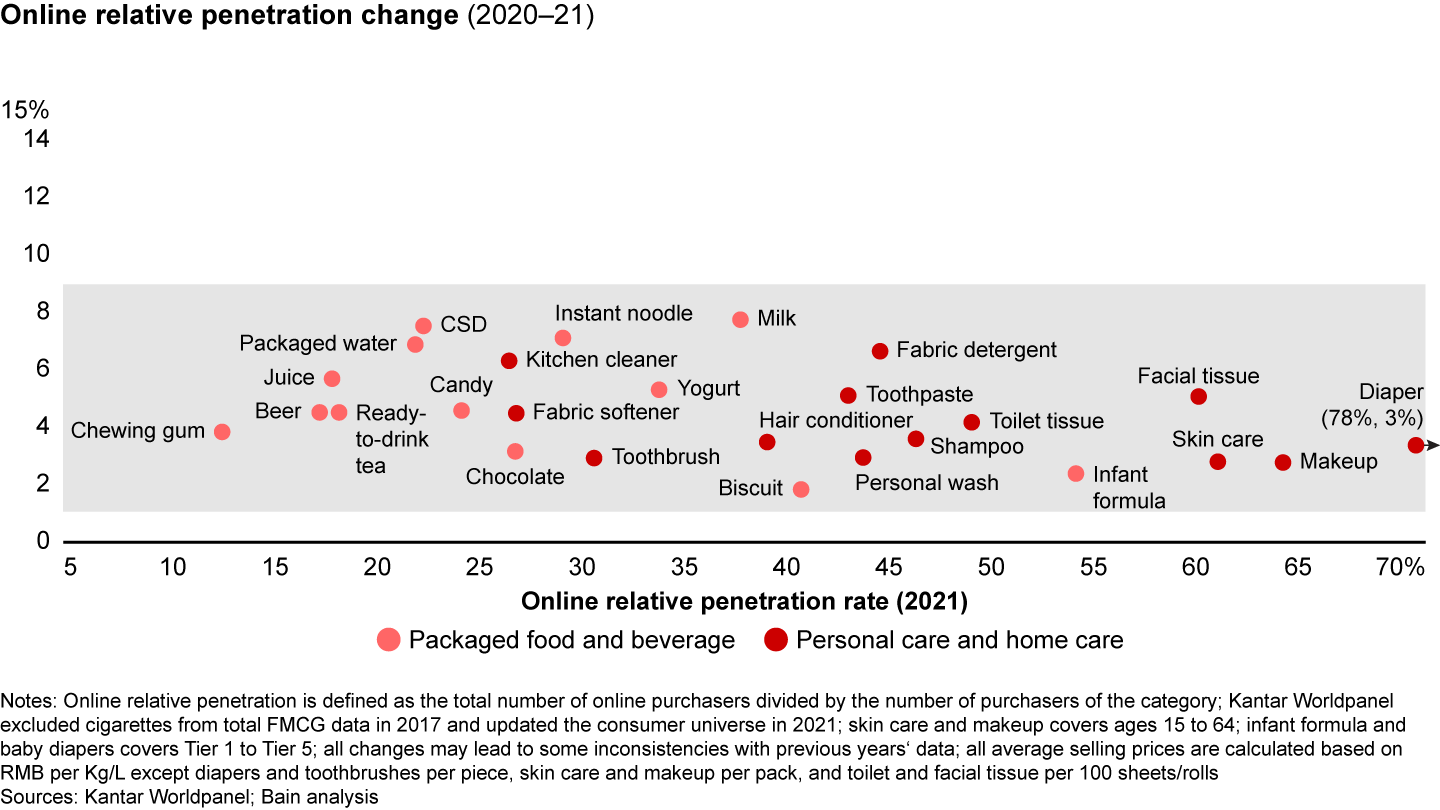
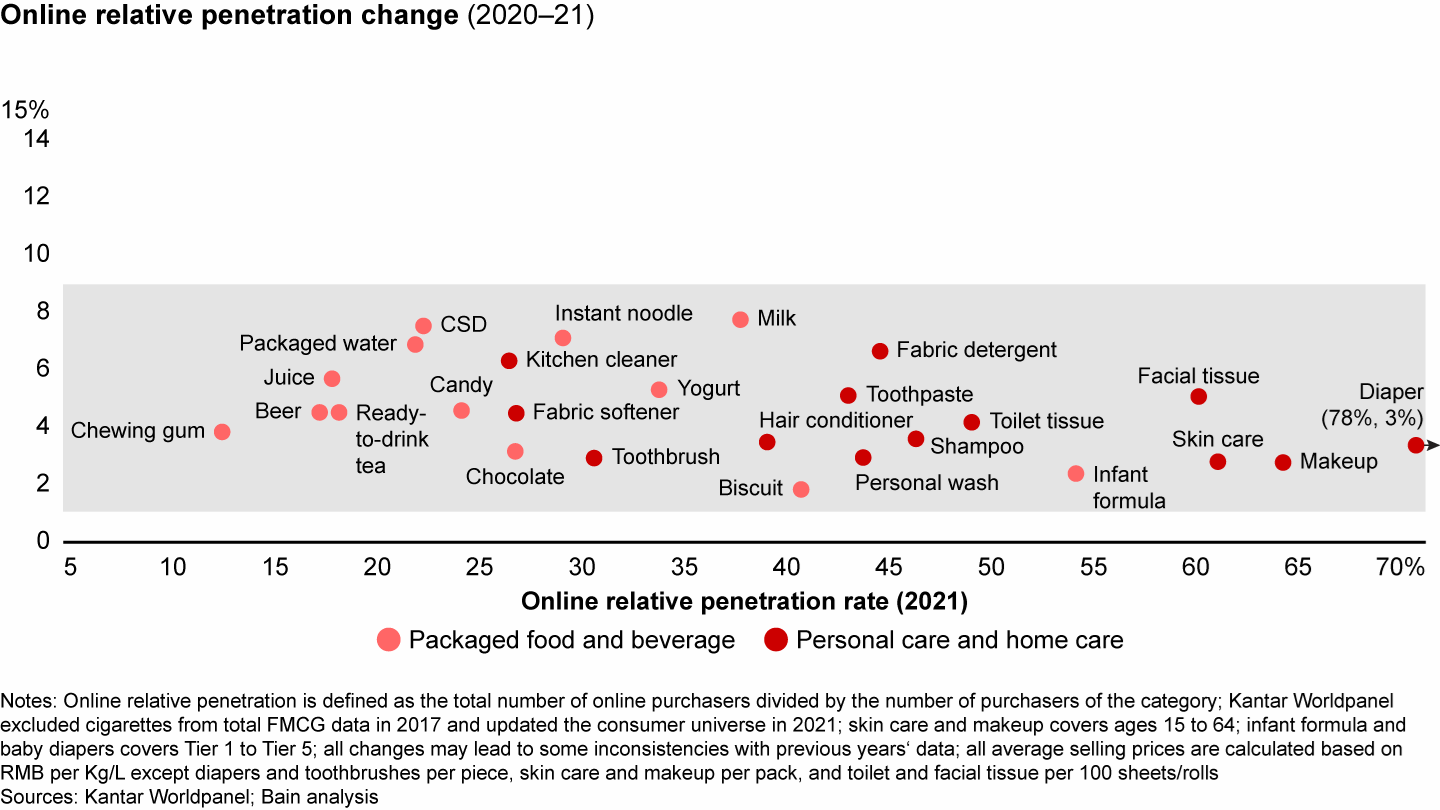
Another big trend of 2021: E-commerce platforms have become increasingly fragmented. Consider that Alibaba’s share shrank from 60% in 2017 to 44% in 2021. Meanwhile, Pinduoduo and the interest-ecommerce platforms (Douyin and Kuaishou) made significant share gains in the past two years. Interestingly, e-commerce platforms grew by shifting from a heavy reliance on key opinion leaders (KOL) to equal emphasis on KOLs and brands’ self-operated livestreaming. As we predicted in previous reports, consumers spent more time watching and making purchases from short videos and livestreaming on these and other sites. These emerging players take distinctly different approaches. For example, Douyin focuses on branded products, especially in higher-tier cities, while Kuaishou has more nonbranded goods and targets lower-tier city consumers. Also, Douyin’s shoppers tend to be younger than Kuaishou’s, on average. The best companies are responding by reevaluating their e-commerce channel strategy across platforms, striving for portfolio differentiation and specialized operating capabilities to reach different consumer segments and satisfy different needs.
Finally, it’s important to point out that O2O sales, which doubled in 2020, grew even faster in 2021, when it rose 2.6-fold. While fresh produce makes up a large part of the O2O market, FMCG penetration in O2O (which doesn’t include fresh produce) grew steadily and now is at 58%. Fully 83% of the FMCG sales generated in O2O represent a shift from offline sales, while 17% is purely incremental business to the categories purchased. The incremental growth is mostly the result of an increase in the number of shopping trips (see Figure 11). When O2O cannibalizes offline sales, it usually hurts the larger channels of hypermarkets and supermarkets.
In key FMCG categories, 17% of online-to-offline sales are incremental to the category and mainly the result of an increase in shopping trips
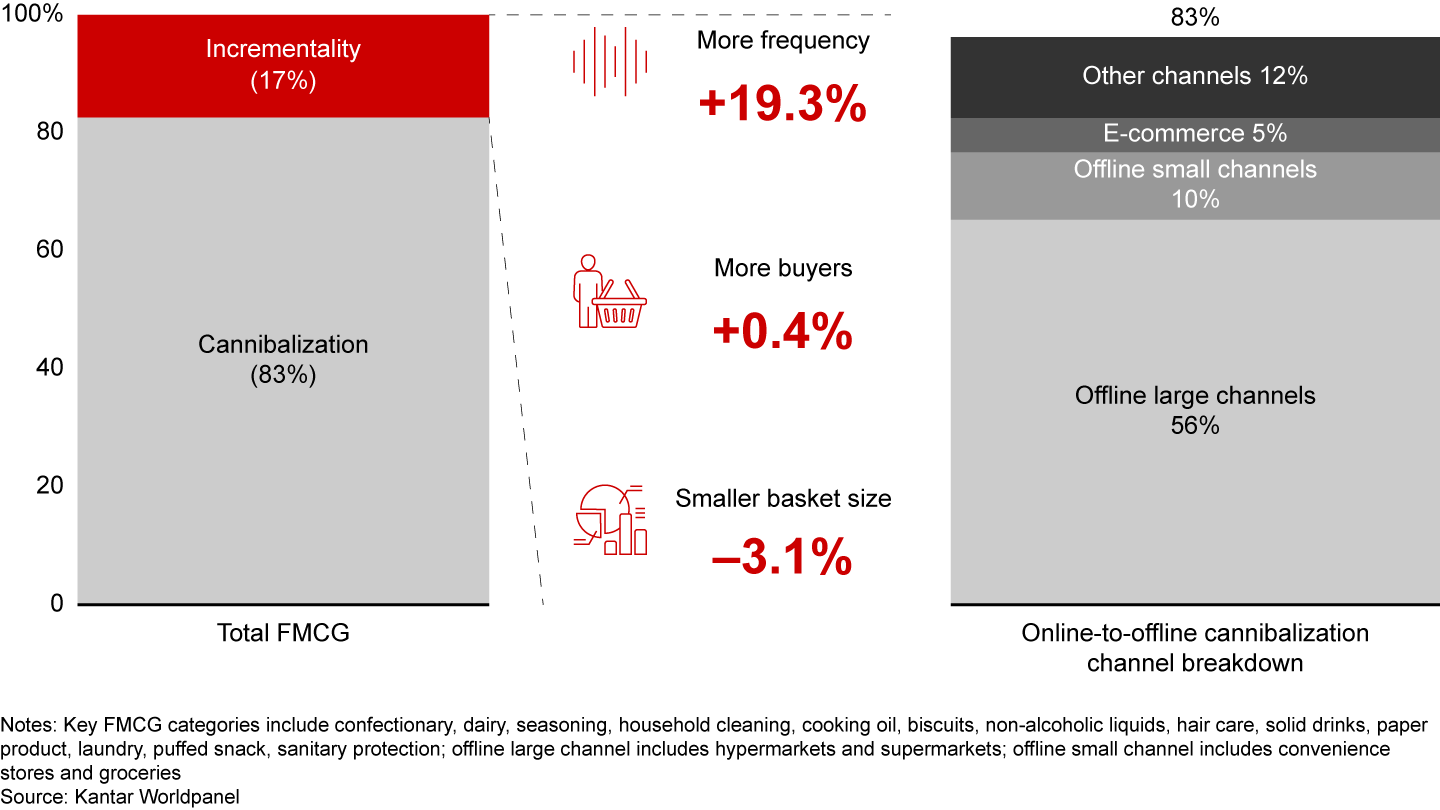
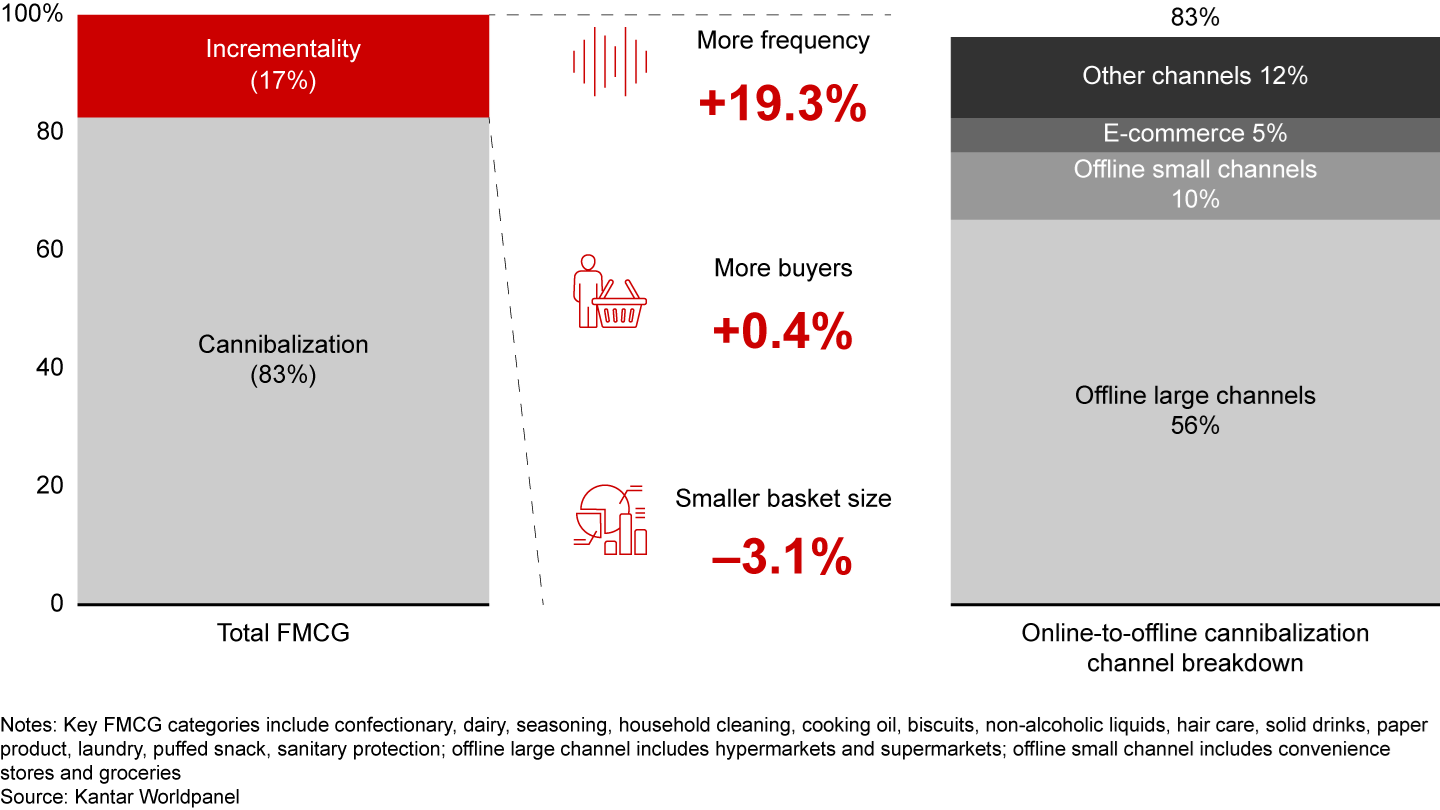
There are four models for O2O, each with a different value proposition and economic model.
Offline retailers such as RT-Mart (大润发优鲜) or Walmart offer O2O services via self-owned or third-party delivery capabilities. They mostly attract previous regular shoppers of their offline stores, using the O2O business to supplement a soft hypermarket sector.
Vertical grocery e-commerce retailers such as Dingdong Maicai (叮咚买菜) and Missfresh (每日优鲜) rely on self-owned dark stores and their own delivery capabilities. They typically offer higher-quality fresh produce, and mainly in Tier 1 and Tier 2 cities. The vertical grocery model requires high capex to build dark stores in high-density communities, with profitability highly dependent on the number of orders per dark store. Because this model’s best potential is in condensed urban areas, expansion potential might be limited.
Community-based group-buying platforms such as Duoduo Maicai (多多买菜) and Meituan Maicai(美团买菜) rely on community captains to coordinate orders and delivery, and manage offline pickup points. This model offers lower-priced products but sacrifices on the delivery experience—shoppers need to pick up the goods themselves from community captains. Community group-buying benefits from lower customer acquisition costs and lower delivery costs than vertical grocery e-commerce. By reducing price subsidies for acquiring customers, leading players can put themselves on the path to profitability. During mid-2021, community group-buying platforms faced tight regulations involving competition and price, and many smaller regional players were squeezed out of market by large platform players such as PDD and Meituan. This resulted in flat sales for the second and third quarters of 2021. Since then, the market has become more consolidated, and with healthier competition, resulting in significant market growth.
Horizontal marketplace platforms such as Meituan (美团) and Ele.me (饿了么) serve retailers and brands with their O2O distribution capabilities. This model offers consumers convenient access via platform super-apps and a wide range of product choices from a variety of stores. Horizontal marketplaces are likely to continue to scale their platforms for steady growth.
Among these models, the biggest boost to O2O sales in 2021 came from community group-buying platforms and horizontal marketplaces, both of which offer a solid value proposition and have stronger platform economics potentials as they scale up.
Insurgent vs. incumbent, local vs. foreign
Our assessment of brand performance compared category share gains and losses between big consumer goods players and their smaller insurgent counterparts and between domestic and multinational companies.
In the big vs. small analysis, we found that the top 20 brands continued to lose share to insurgents in most categories in 2021, while starting to regain lost share in a few categories, like hair conditioner, packaged water, makeup, and infant formula. The biggest share gains from smaller brands were in fabric softener, ready-to-drink tea, and carbonated soft drinks. However, the top five brands still contributed most of the value growth in carbonated soft drinks and milk.
Our domestic vs. multinational analysis uncovered distinctly different paths to growth. Local brands focused on volume growth while foreign brands relied on premiumization to grow (see Figure 12). Domestic brands within the 26 categories grew 4.5% in 2021, and foreign brands grew only 0.8%. While both local and foreign brands suffered in 2020 during the Covid pandemic, it was domestic companies that recovered more throughout 2021 as multinationals continued to lose share on an aggregate basis, especially in such categories as infant formula, carbonated soft drinks, diapers, and shampoo. However, foreign brands gained share on an aggregate basis in categories like beer and gum.
Foreign brands continued to rely on premiumization to grow, while local brands focused more on volume growth
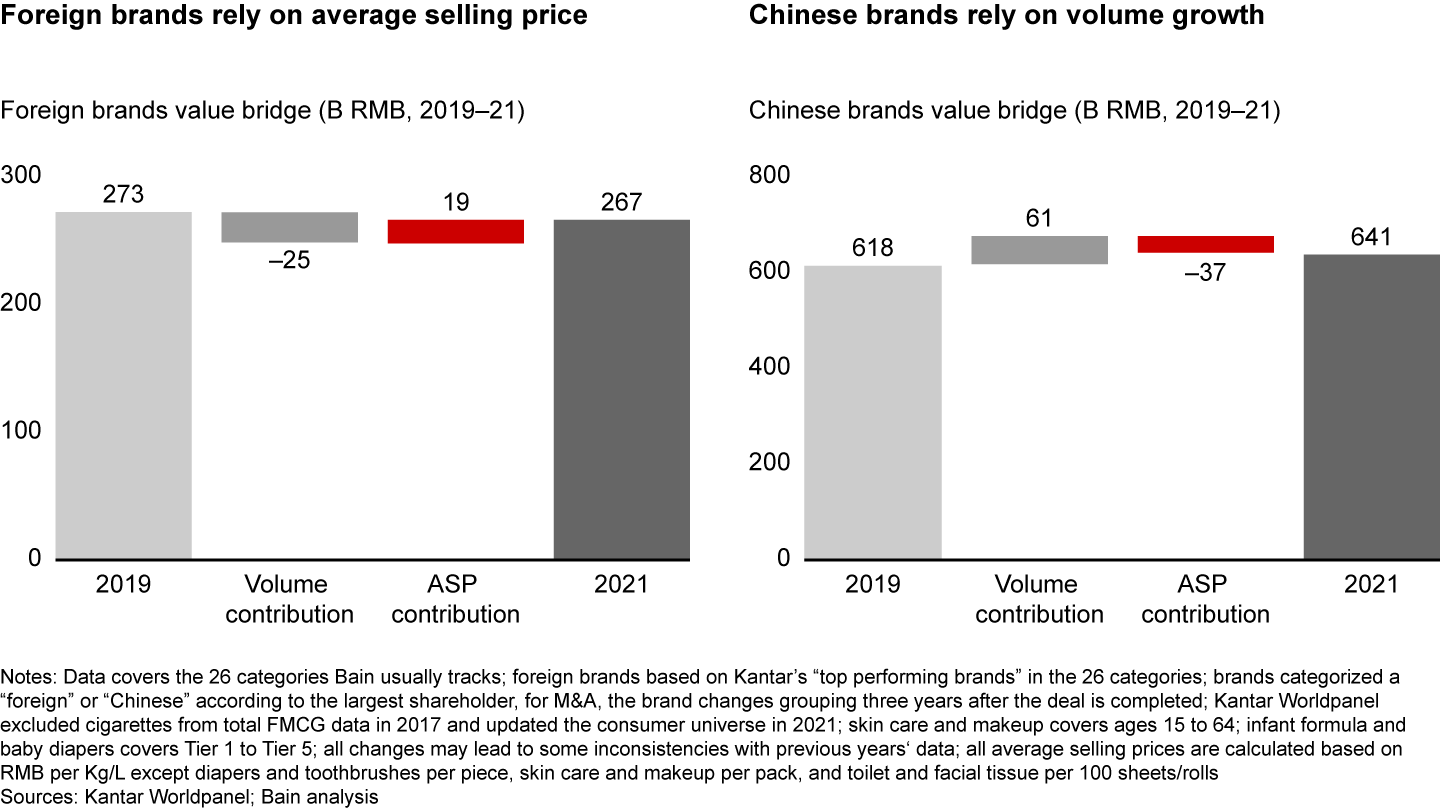
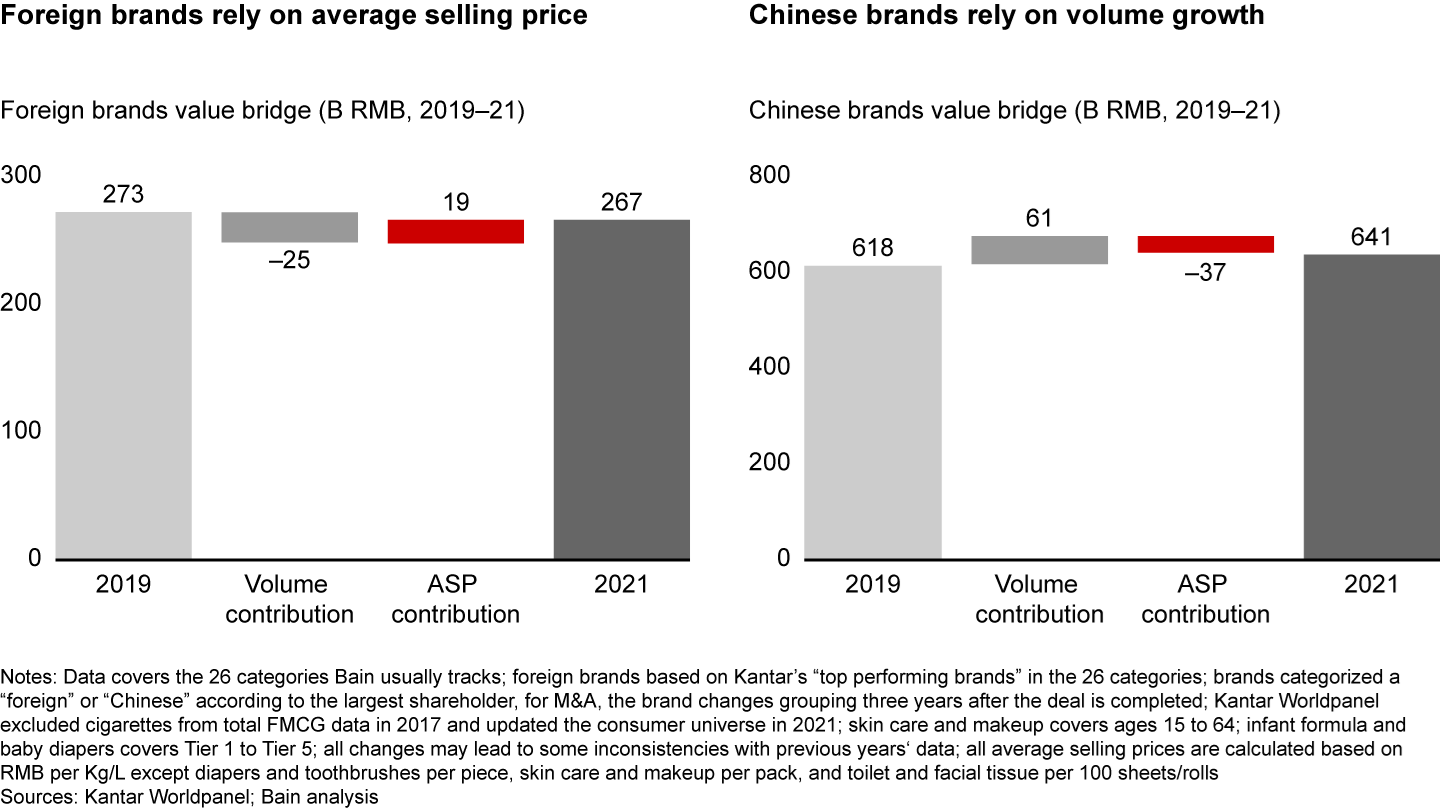
Despite inflation in raw materials, the prices that consumers actually paid declined as volume rose. As we mentioned, in the uncertain economic environment, consumers either bought on promotion or shifted to cheaper products. Overall, Chinese insurgent brands did the better job of benefiting from this trend by offering high-quality but lower priced products. In contrast, most multinationals, which are better positioned to play in premium segments, struggled to compete in value segments. In many categories, they may have pushed their premiumization strategy too far, resulting in market share losses. There is evidence that such consumer preferences are likely to stay amid Covid outbreaks, suggesting that foreign brands may consider rethinking their portfolio strategy.
Even in an environment of weakened consumer confidence, we see foreign companies such as AB Inbev and local players like Genki Forest deploying premiumization strategies that successfully encourage consumers to trade up to higher-end SKUs, especially in higher-tier cities, with a distinctive brand proposition or consumption occasion.
At-home vs. out-of-home
In 2017, we first quantified a rise in out-of-home FMCG consumption. More important, we wanted to track how convenience and grocery channels, which had been watching at-home consumption sales decline, were actually growing sales for out-of-home consumption. Of course, the Covid outbreaks in 2020 and more recently in 2022 gave a lift to at-home consumption, confirming that consumers’ homes serve as their new center for work and entertainment, in addition to living.
For the 11 major categories3 that overlap between at-home and out-of-home consumption, consumers are showing distinct preferences for the channels from which they purchase for both out-of-home and at-home use. For example, among these 11 categories in food and beverages bought for at-home consumption in Tier 1 and Tier 2 cities, only 4% is purchased in convenience stores. By comparison, 35% of these 11 categories in food and beverages for out-of-home consumption is bought in convenience stores (see Figure 13). Convenience stores and groceries are very important for out-of-home purchases. In fact, the two channels accounted for more than half the total value of goods sold for out-of-home consumption for these 11 categories. In these same categories, hypermarkets, super-mini stores, and e-commerce are the three largest channels for at-home purchases, with e-commerce growing the fastest.
At-home consumption continues to grow, with different channel and category dynamics than out-of-home consumption
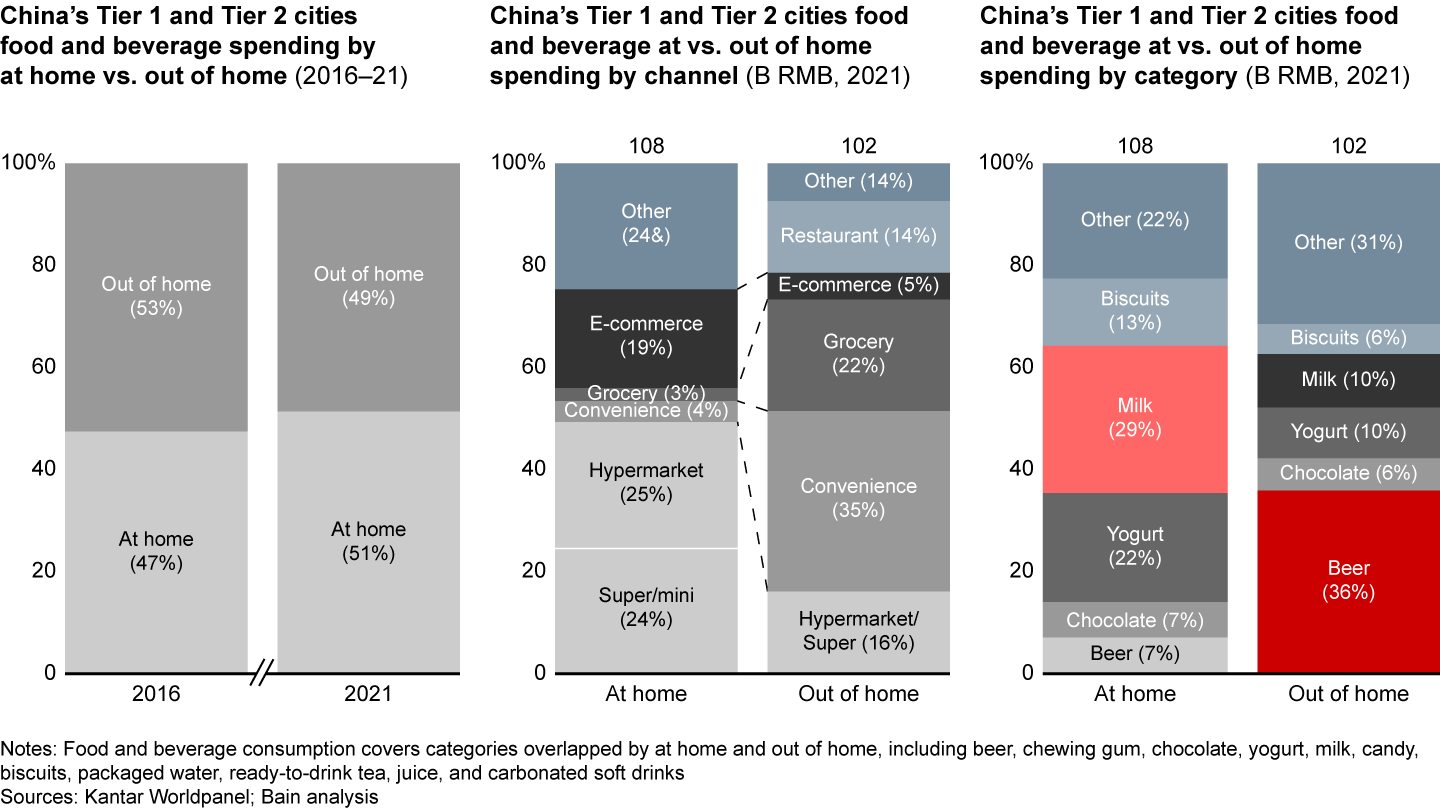
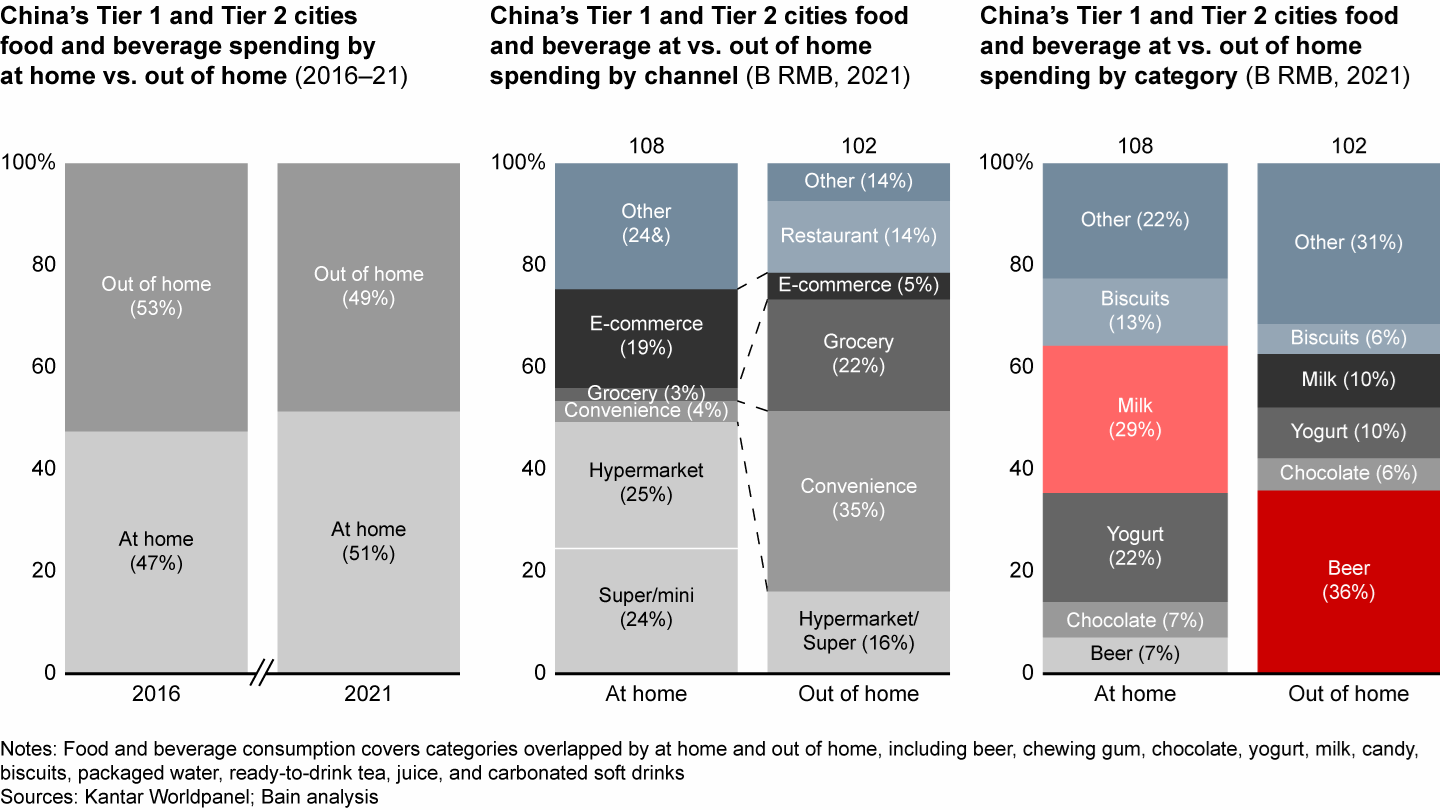
Looking at it from a category perspective, there are distinct channel trends. For example, within these 11 categories, beer represents 36% of out-of-home spending, but only 7% of at-home spending. Milk is the biggest category for at-home consumption (29% of spending) but represents only 10% of out-of-home spending.
What’s ahead in 2022
Covid’s shadow on FMCG sales
China’s market for fast-moving consumer goods was dealt a blow when some of the country’s biggest cities started locking down in March and April. It was an unwelcome return to the anxious, troubling early days of the pandemic in 2020, and consumers’ worries were reflected in their purchasing behavior. There was a strong sense of déjà vu as shoppers stocked up on food and home care products in larger pack sizes. With nowhere to go, they spent less on some categories such as high-priced skin care and makeup.
Most FMCG companies are now struggling to deal with the effects of the lockdowns. Yet forward-looking companies have acknowledged that their 2022 performance will be disappointing and volatile, and they are solidly focused on what lies ahead, using as a guide the trends that emerged in 2021 after the pandemic’s first major wave ended.
The FMCG dynamics of 2021 continued into early 2022 and then changed course in March and April, as Covid’s shadow reappeared in China. In the four weeks ending April 22, volume grew by 5.6% compared with the same period the year earlier, and ASP dropped by 5.7%, registering the biggest decline in prices in recent years (see Figure 14).
Prices declined heavily in March, dragging down the overall FMCG market growth, while volume growth was driven by stocking up
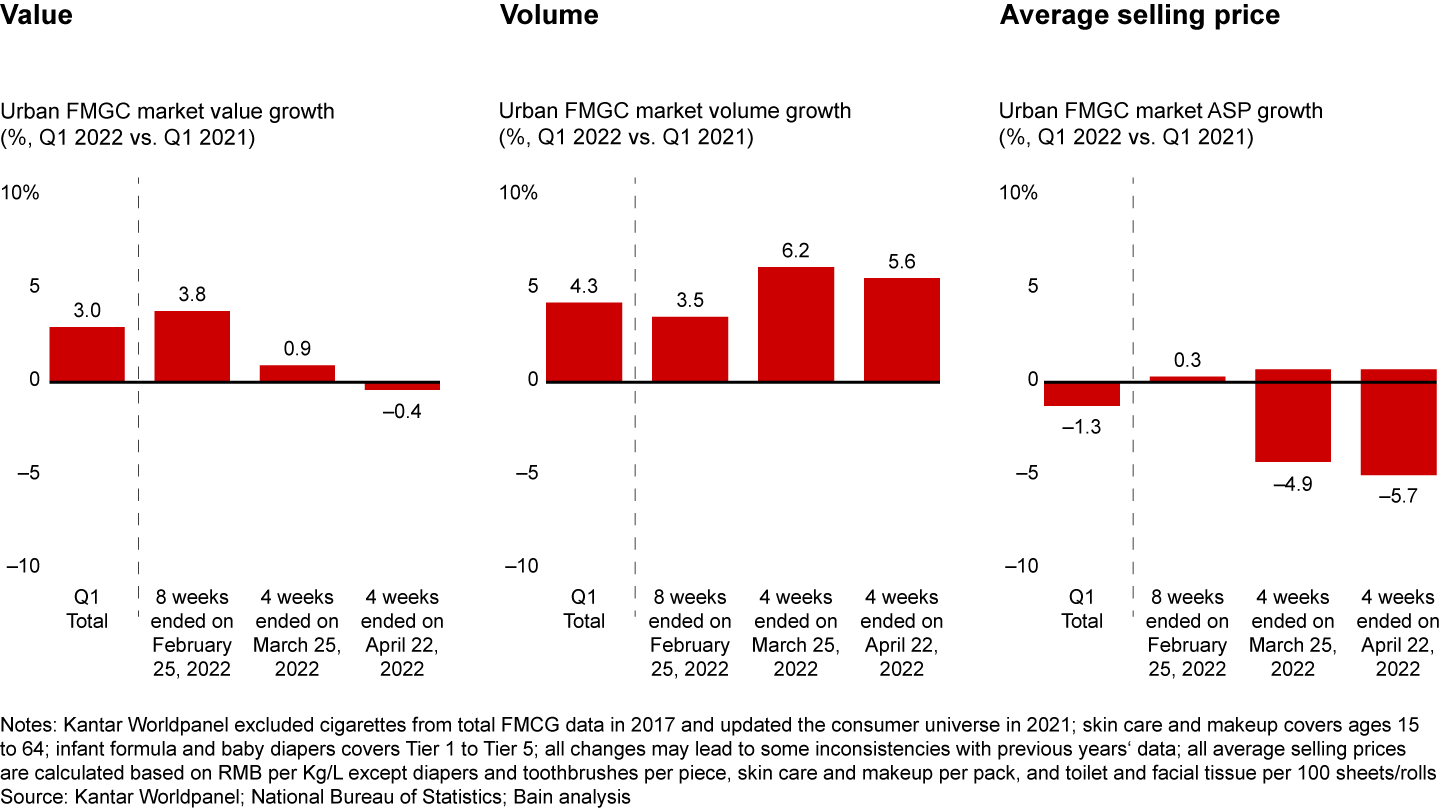
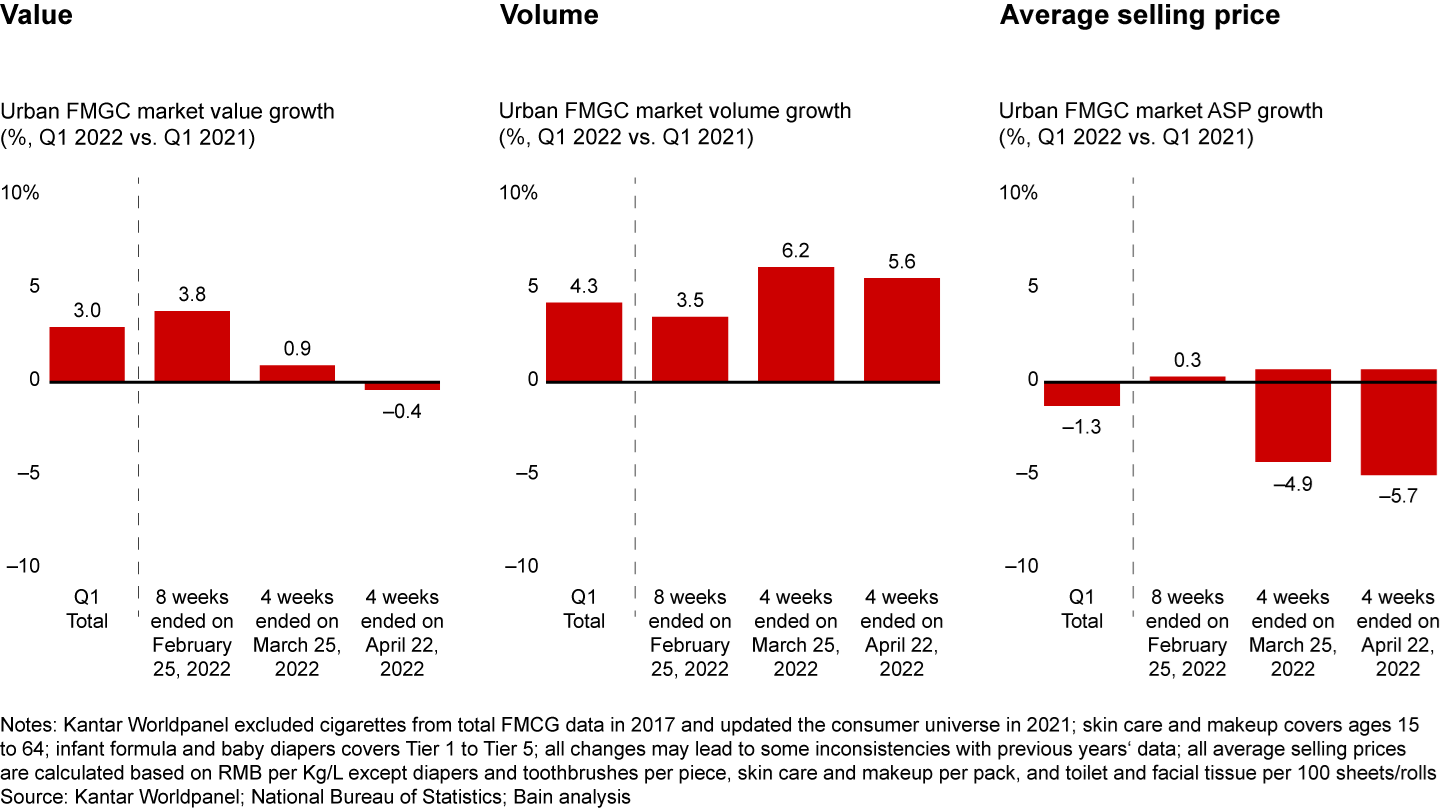
January and February saw 3.8% value growth that dropped to .4% in April, the impact of lockdowns in such important cities as Shanghai and Shenzhen. Also, the two-speed spread between the food and beverage sector and the personal and home care sector began to reemerge, but for the first time in recent years, food and beverages grew faster than personal and home care. Beverages grew robustly in January and February and then declined by 1.1% in March and by 1.2% in April. Personal care, which performed weakly with .8% growth in January and February, dropped by 4.3% in March and by 8.8% in April. Consumers traded down in skin care and found fewer occasions to use makeup. However, home care sales stayed healthy, even growing by 8.7% as consumers stocked up in March and 2.6% in April (due to limited purchasing channels during lockdown). Packaged food grew 7.2% in April, due to stock-up and the fact that food still can be purchased through community group buy and limited online platforms.
Looking back to plan for the future
In many ways, the resurgence of Covid outbreaks and the return of citywide lockdowns bring us back to the first quarter of 2020. Back then, we identified four distinct growth trajectories that FMCG categories exhibited due to Covid-related factors. As Covid’s impact started easing in the second half of 2020 up to January and February of 2022, those four categories’ trajectories converged. The country enjoyed a relatively normal Chinese New Year holiday. But by March and April, when the omicron variant unexpectedly hit many parts of China, those distinct growth trajectories began diverging again (see Figure 15). Here’s a snapshot:
As they did in 2020, the four distinct category growth trajectories diverged again in March 2022 after a long converging trend
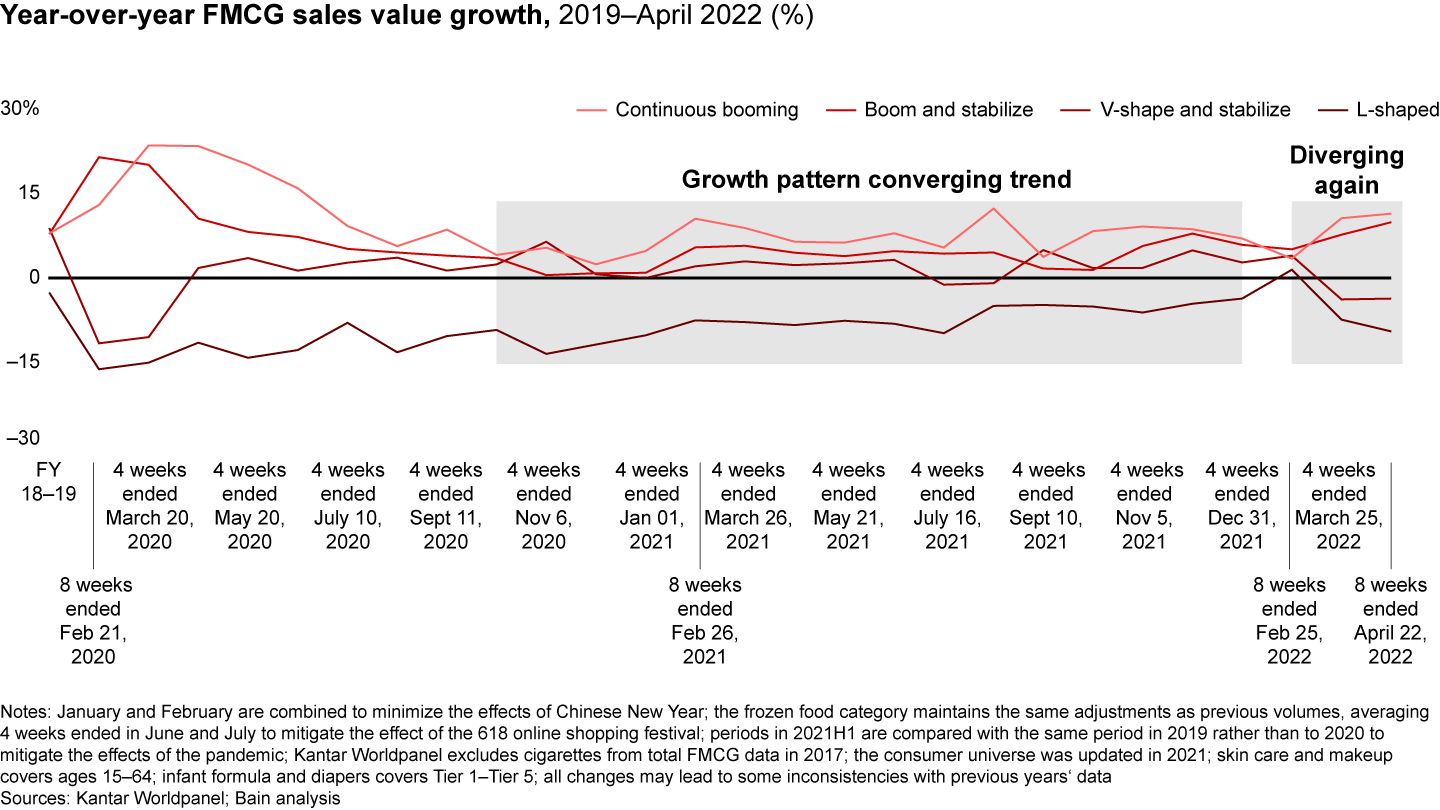
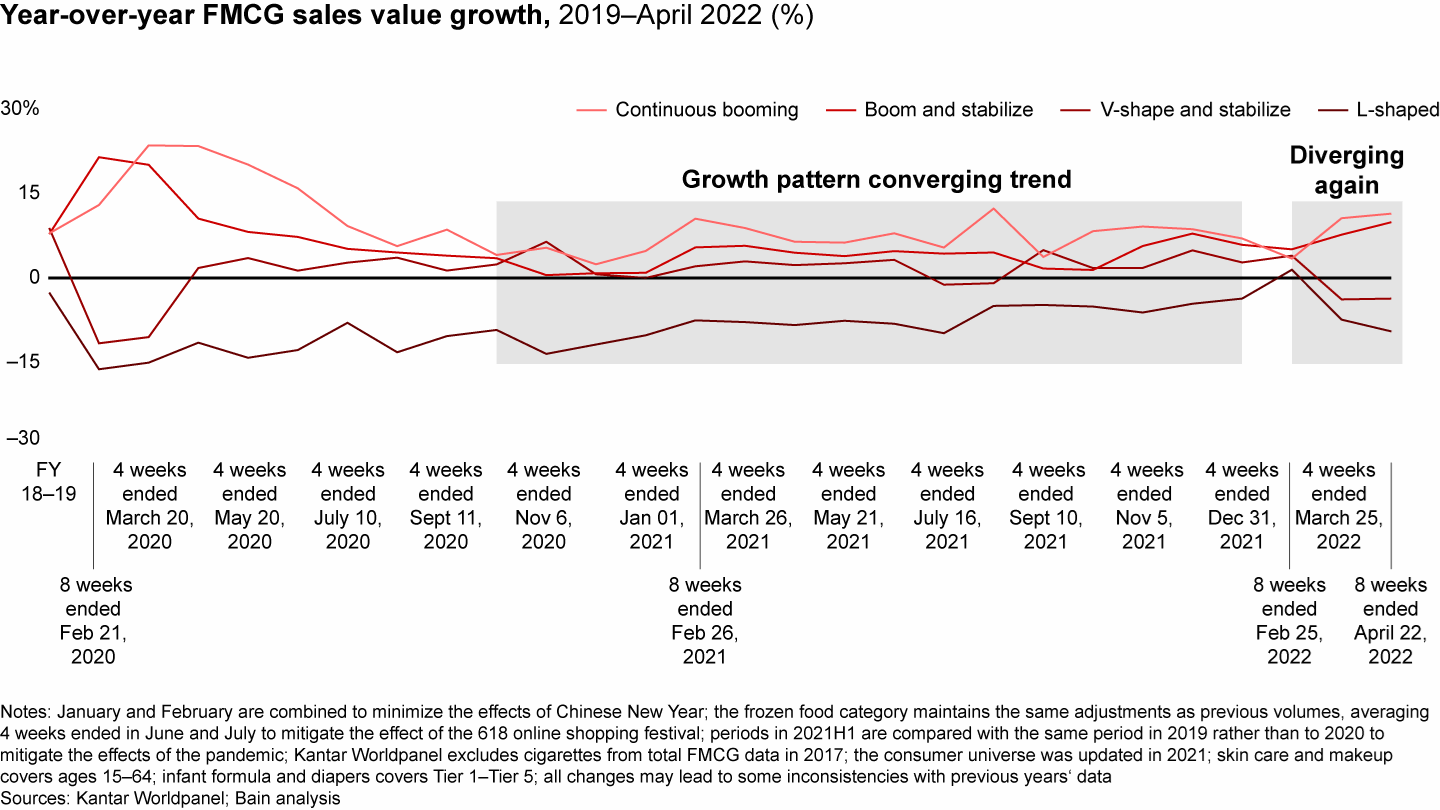
Categories that benefited from Covid, followed by slower and stable growth: Carbonated soft drinks maintained high growth during Chinese New Year and then accelerated in March and April, increasing 22% and 23% respectively, as consumers wanted to enjoy beverages during the lockdown. Soy sauce sales increased as consumers cooked at home more frequently.
Categories that boom during Covid but with a boom that is not sustained: Instant noodle growth declined as Covid waned in China in 2021 and early 2022, but then grew strongly at 28% in March and 43% in April as consumers stocked up. The same trend was seen in packaged water sales. For health purposes, consumers stock up on packaged water to replace tap water.
Categories that are hit by Covid but rebound afterward (V-shape): The lockdowns hurt personal care categories such as skin care, which lost 9% in March and 11% in April, and toothbrushes (–32% in March and –27% in April). Consumers didn’t repurchase these categories. But demand is expected to return to normal after the Covid restrictions lift.
Categories that continue to decline (L-shape): Makeup never returned to its pre-Covid 2019 level and even continued to decline—by 21% in March and 26% in April. There are fewer social gatherings and other usage occasions. Another category that feels the pinch: With fewer gift-giving occasions and family gatherings, demand for wine and foreign spirits has dropped.
As Covid restrictions ease we expect category performance to resemble what transpired after the first quarter of 2020. However, as we will describe below, the implications on premiumization trends will differ, as consumers will remain more cautious.
Impact on premiumization across categories
Different categories now show distinctly different approaches to premiumization, depending on consumer demand, supply constraints, government regulations, and the driving force from brands (see Figure 16):
FMCG categories experienced four distinct pricing patterns
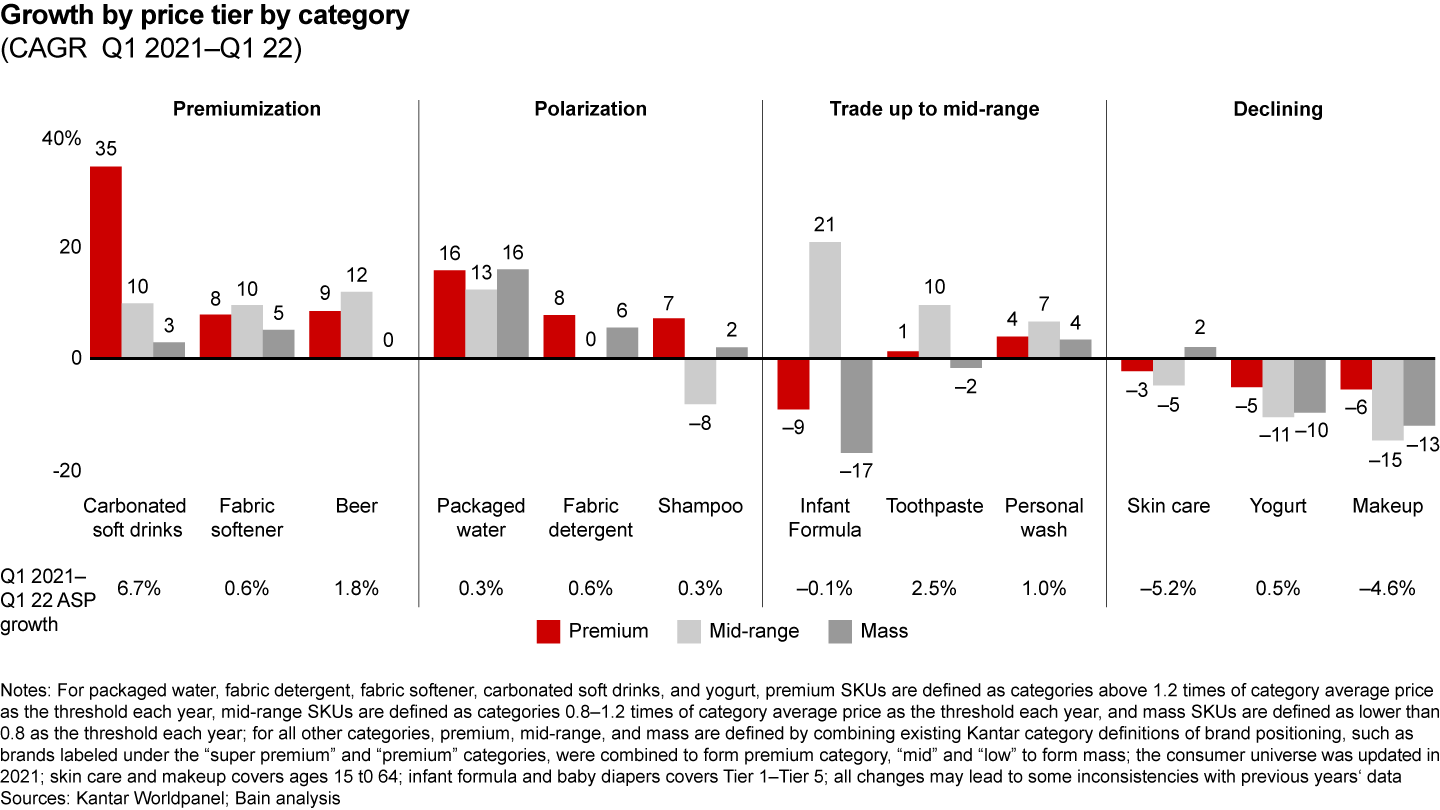
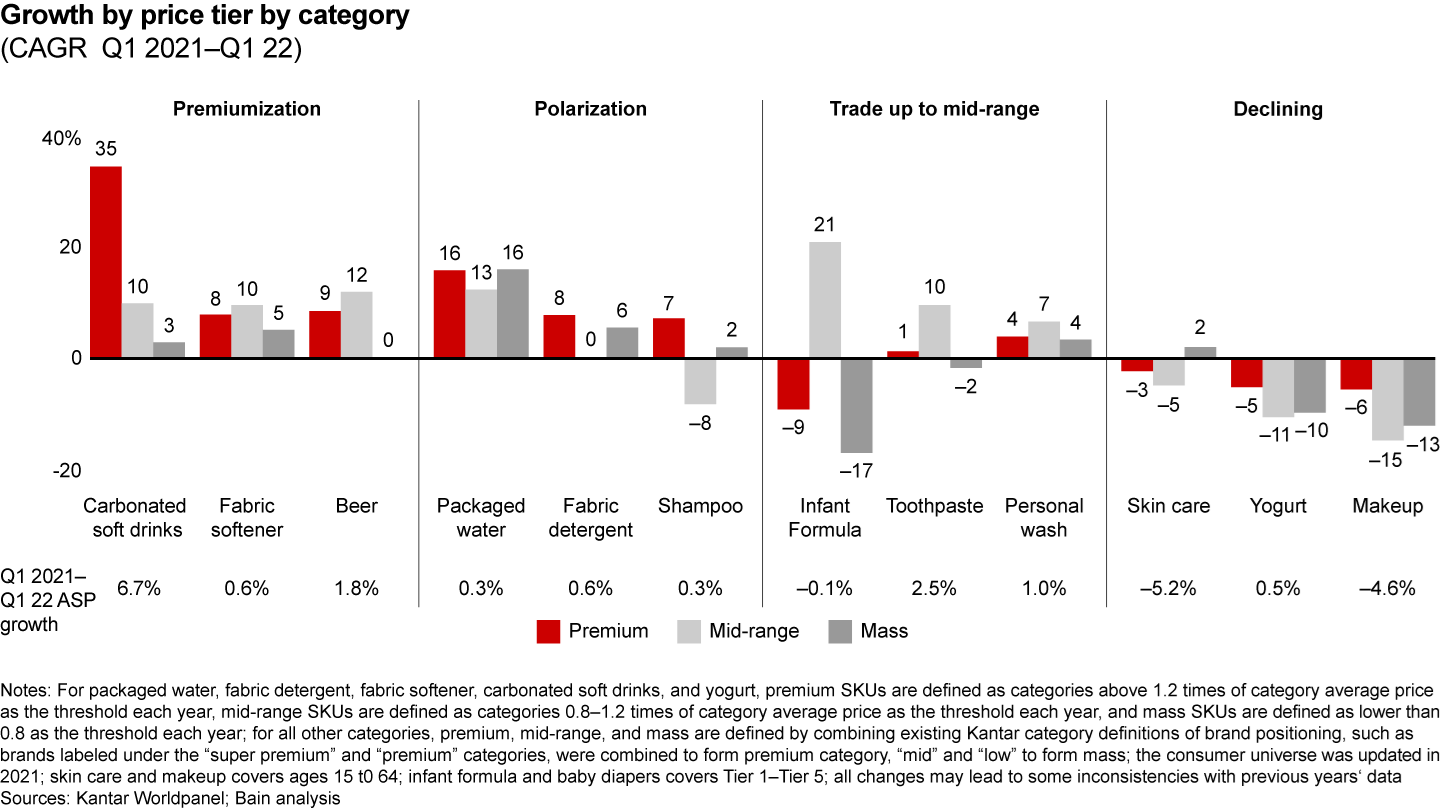
Continuous premiumization. Consumers continued to trade up in carbonated soft drinks to the point that premium sectors grew 35% in the first quarter of 2022, evidence that consumers prefer healthier soft drinks with no sugar and zero calories. Overall, prices are increasing for carbonated soft drinks across different price tiers. Meanwhile, the beer category is enjoying higher prices due to consumers’ positive reactions to brand innovations.
Polarization. On the one hand, fabric detergent and shampoo brands are launching premium products to meet consumers’ more sophisticated needs—everything from laundry liquid for underwear to styling shampoo. But brands in these categories also are selling in lower-priced multipacks and large packs aimed at mass segment consumers who are stocking up.
Trade up to midrange. In categories such as infant formula, toothpaste, and personal wash, companies are leading consumers to move up from mass products to midrange products. For example, infant formula brand Junlebao successfully grew its midrange by trading up lower-tier-city parents. At the same time, the high end in many categories is under pressure as more consumers shift to value-for-money products. Another factor in the growth of the midrange: Some multinationals are establishing or expanding factories in China—and finding that their mid-priced, locally produced products are popular with consumers.
Trading down/declining. Skin care is trading down, and the mass segment is the only area of growth. Prices in the premium segment declined by 14% in the first quarter of 2022, as many companies sold on promotions. Chinese insurgent brands, which offer more value-for-money products, continued to win consumers. Categories such as yogurt and makeup see steady declines in ASP across price segments.
The overall pricing decline is more the result of consumers buying larger pack sizes and mid-tier products than it is the result of an increase in promotions. Premiumization is possible in some categories; however, companies need to acknowledge that consumers, facing an uncertain economy, may accelerate the shift to value products. Brands may not be able to drive growth by just relying only on premiumization, and in some categories they need to consider meeting consumers’ demands for value segments.
Channel dynamics
E-commerce leader Taobao/Tmall continued to lose share in the first quarter of 2022, while O2O channels gained momentum, growing 34% over the same quarter of 2021. After strict government regulations, community group buying platforms returned to robust growth the fourth quarter of 2021 and continued high growth in the first quarter of 2022. Now these platforms are trying to expand into Tier 1 cities as they continue to grow to become an important FMCG channel.
What’s ahead?
Unexpectedly, China is in the middle of the most serious Covid situation since 2020. Turbulence and uncertainty are likely to remain concerns for a large part of 2022, with consumers responding by becoming increasingly more price sensitive in many categories. The signs are everywhere. Disposable income growth and salary growth slowed down. The unemployment rate rose to 5.8% in April, the highest since 2020. Financial markets have lost 20% value in the first five months of this year, suppressing consumers’ spending power. The real estate market is still under intense pressure that started in the early days of the pandemic.
But challenging times always create opportunities. At-home consumption will benefit many categories, especially in food and beverages and home care. Consumers’ growing concerns for health and hygiene will continue to spur growth in milk, personal wash, and other categories. The trend in which consumers shift their purchasing to midrange and mass segments opens potential for companies to sell products in these price tiers—something Chinese insurgents have done exceptionally well. Finally, new e-commerce platforms like livestreaming, PDD, and community group-buying platforms will grow their presence and influence, offering brands great access to lower-tier-city consumers—and, now in Tier 1 and Tier 2 cities—in a more direct way.
Looking farther out into 2023, there is reason for optimism. The long-term fundamentals are in place for a return to healthy growth. Inflation remains relatively lower in China compared with Western markets, and the energy crisis is under control, with strong indications that the government is still striving to maintain GDP growth and is committed to balancing Covid clearance and economic development. A government stimulus package will also likely boost consumer spending power. Just as they have prepared for the challenging times, the best FMCG companies will prepare for a likely rebound.
Implications for brands and retailers
Implications for brands
Uncertainty introduced in 2020 by the outbreak of Covid was a dress rehearsal for volatility in the years to come. This year, amid another Covid outbreak in China against a backdrop of dynamic global geopolitics, we believe businesses may need to accept that volatility is the new normal. Companies should proactively practice scenario planning and be ready for various potential outcomes instead of counting on succeeding with a single plan. They should also build agile capabilities within their teams to react effectively. For consumer goods brands specifically, that means closely watching the following:
- Product/brand portfolio: Assess varying opportunities by price segment and city tier, customizing portfolio strategy to capture them with different product propositions, instead of focusing on only one segment.
- Supply chain optimization: Simultaneously manage the pressure on cost structure and the development of resilient supply chains to ensure business continuity under all scenarios. This will require companies to leverage a large supplier pool in different geographies (and in China in particular), and also to look for automation opportunities to reduce costs.
- Integrated online and offline route-to-market: Diversify into insurgent channels (such as PDD, livestreaming, and community group-buying platforms) in the short term and build direct-to-consumer capabilities to integrate online and offline channels in the long term.
Brands should also be optimistic about the future, and expect a much better 2023—similar to how 2021 compared with 2020. The fundamentals of the Chinese economy remain strong, with a growing middle class, continuous urbanization, and inflation under control. Brands should use the year 2022 to prepare for a strong rebound in 2023.
Implications for retailers
As we have seen again in Q2 2022, the retail landscape also will be profoundly impacted by Covid-19, and retailers need to:
- build resilient supply chains so that they can ensure business continuity even in the event of high disruptions
- redefine the retailing value proposition to shoppers in an increasingly digitalized and omnichannel environment
- focus on categories where there is a higher chance to win vs. online
- focus on fresh, high-quality food offerings and, more broadly, on categories with low online penetration
- price competitively to differentiate from online platforms
- double-down on O2O, prioritizing small to midsize stores and convenient locations
- provide consistent experience in offline stores, online self-owned app, community buying and other horizontal O2O platforms
- enhance the physical store experience, upgrading digital features to make stores more appealing to younger consumers
- reduce complexity in operations, look for alternative sourcing options and establish a new cost baseline in order to cope with the increasing input and energy costs.

Kantar—Understand People, Inspire Growth
As part of Kantar, the world’s leading marketing data and analytics company, Worldpanel provides brands and retailers with a unique, 360-degree understanding of consumer behaviour across the globe. We are shopper-centric, continuously monitoring the purchase and usage behaviour through the largest omnipanel in the world to shape the brands of tomorrow by better understanding people everywhere. With unparalleled datasets, pioneering technology and expert analysts, we partner with brands and retailers of all sizes, empowering them to reimagine what’s possible, and change the landscape to create a better, healthier, more sustainable and inclusive world. In the China market, the Worldpanel division is one of the services in CTR, covering over 100 FMCG categories, 50,000+ brands and 100+ retailers, among many others.
Notes
- These 26 categories are (a) packaged food: biscuits, chocolate, instant noodles, candy, chewing gum and infant formula (b) beverages: milk, yogurt, juice, beer, ready-to-drink tea, carbonated soft drinks and packaged water; (c) personal care: skin care, shampoo, personal wash, toothpaste, makeup, hair conditioner, diaper and toothbrushes and (d) home care: toilet tissues, fabric detergent, facial tissues, kitchen cleaner, and fabric softener.
- These 17 categories are frozen food, cheese, soy sauce, ice cream, soybean milk, Chinese spirits/sake, foreign spirits, wine, mouthwash, disinfectant, wet tissues, pet food, kitchen rolls, quick soup, nutrient supplements, household cleaner, and hand wash.
- These 11 categories include beer, chewing gum, chocolate, yogurt, milk, candy, biscuits, packaged water, ready-to-drink tea, juice, and carbonated soft drinks.